Fantasy Books
Roy Thomas and the Legacy of Conan the Barbarian
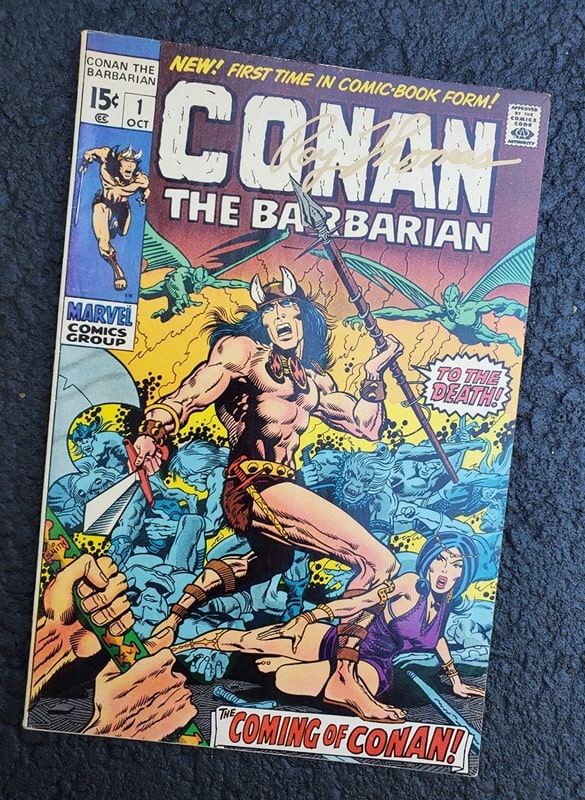 Conan The Barbarian #1 (Marvel Comics, October 1970). Art by Barry Windsor Smith
Conan The Barbarian #1 (Marvel Comics, October 1970). Art by Barry Windsor Smith
The package I received on July 6, 2020 brought me great joy! Roy Thomas is my favorite comic book writer. I correspond with him occasionally, and he is quite generous with his time, sharing his thoughts and memories. Very similar to how Gary Gygax did this, treating every fan with dignity and respect. A true gentleman.
I thanked Roy in my latest Hyperborea adventure book, The Sea-Wolf’s Daughter, because it included a character inspired by one of his creations. I sent him a copy of the book, and along with it my personal copy of Conan the Barbarian #1, to be signed by the author. Well, here it is! (He has an agency that normally handles this sort of thing, but he made an exception for me.) Excelsior!
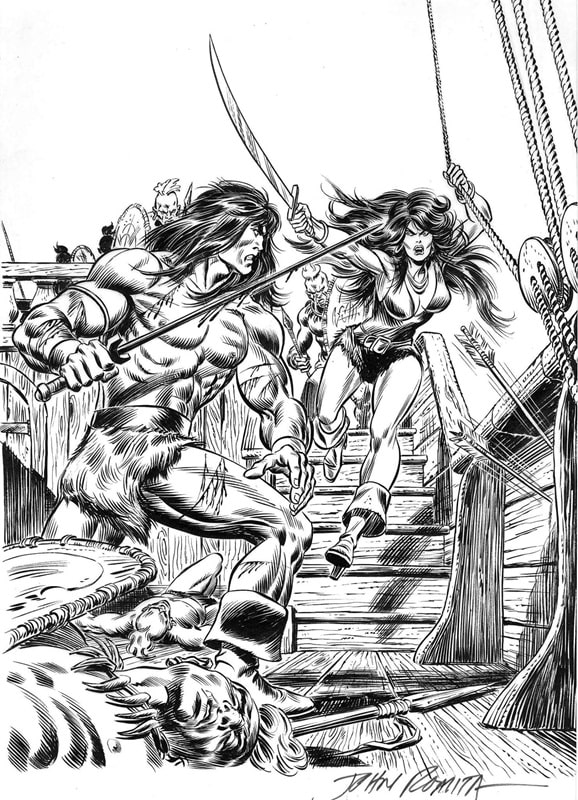 Cover art for Conan the Barbarian #58, by John Romita Sr., story by Roy Thomas (Marvel Comics, January 1976)
Cover art for Conan the Barbarian #58, by John Romita Sr., story by Roy Thomas (Marvel Comics, January 1976)
It is my humble opinion that of all the Conan pastiche writers, Roy Thomas is among the finest. But because he wrote in the comics industry, he’s often not afforded the same prestige as other Conan pastiche writers, such as L. Sprague de Camp, Lin Carter, Karl Edward Wagner, Robert Jordan, et al.
Thomas’ run starring Conan and Belit (the Queen of the Black Coast) started with this issue (#58) and concluded with the iconic issue #100. It is a treasure to read.
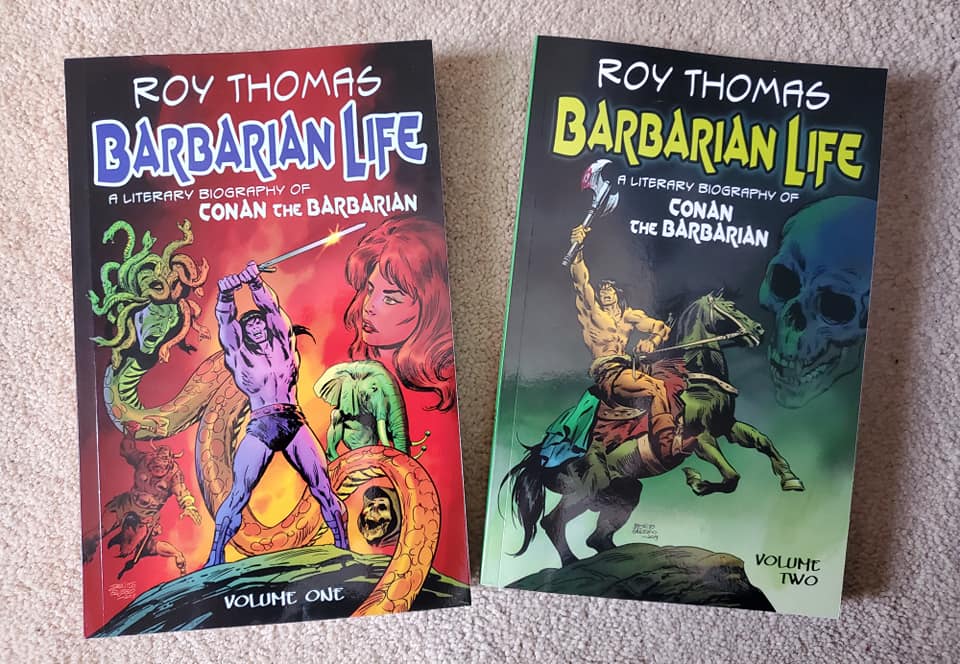 The first two volumes of Barbarian Life by Roy Thomas (Pulp Hero Press, December 7, 2018 and November 29, 2019)
The first two volumes of Barbarian Life by Roy Thomas (Pulp Hero Press, December 7, 2018 and November 29, 2019)
In the three volumes of Barbarian Life, Roy Thomas reflects on each of the first 100 issues of Conan the Barbarian, by Marvel Comics — which he wrote every issue of, from 1970 to 1979.
Roy is responsible for taking part in the creation of many Marvel and DC characters that have been featured in blockbuster films, but he will be the first to tell you that his favorite job was writing Conan the Barbarian, adapting and expanding on the works of Robert E. Howard and several other pastiche writers. What an incredible idea by Mr. Bob Mclain of Pulp Hero Press!
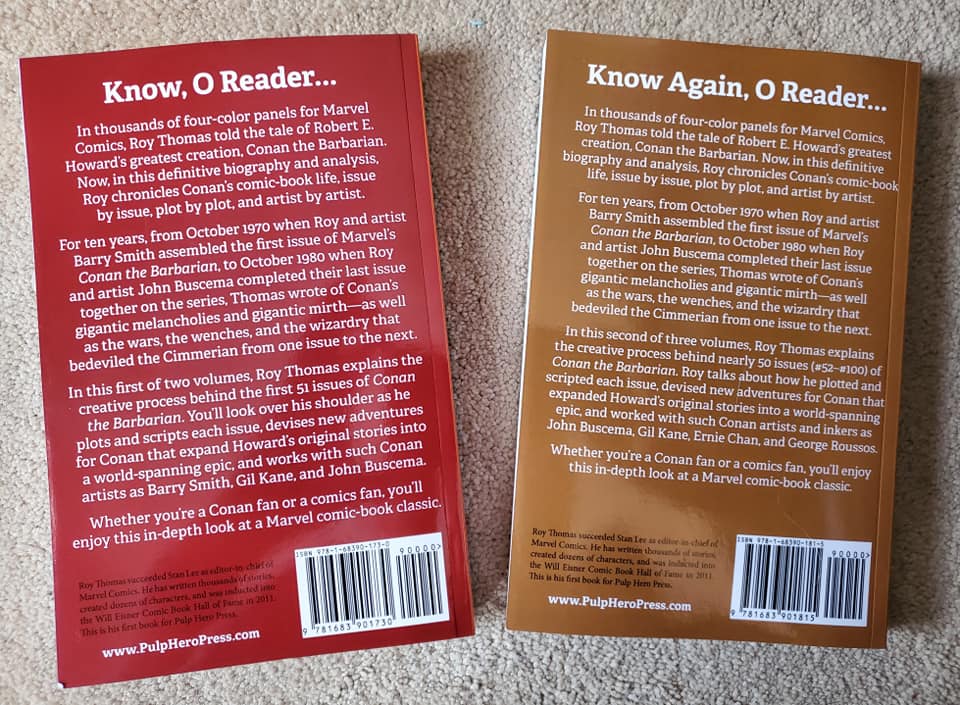 Back covers for Barbarian Life, volumes 1 and 2
Back covers for Barbarian Life, volumes 1 and 2
I can’t wait to dig into these two volumes; in fact, I have this crazy notion in me noggin about starting a blog in which I go through all 100 issues, reading the comic, followed by its respective chapter entry in the literary biography.
I’ve never blogged before, but I think this could be my motivation to give it a try in 2020. Would anyone be interested reading something like this?
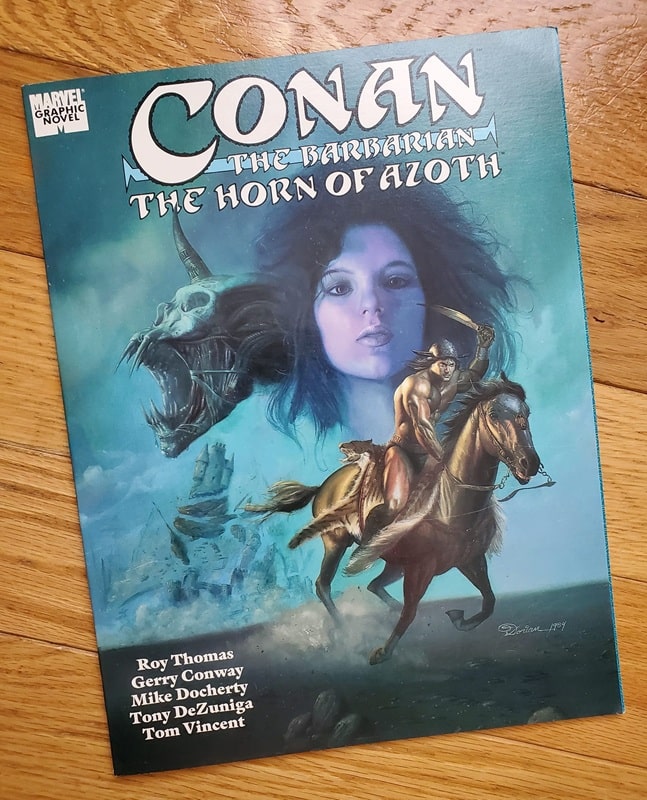 Conan: The Horn of Azoth, by Roy Thomas, Gerry Conway, Mike Docherty, Tony DeZungia, and Tom Vincent (Marvel Enterprises, January 1, 1990)
Conan: The Horn of Azoth, by Roy Thomas, Gerry Conway, Mike Docherty, Tony DeZungia, and Tom Vincent (Marvel Enterprises, January 1, 1990)
Above is Conan: The Horn of Azoth, aka Conan, King of Thieves, aka Conan the Destroyer.
Written by Roy Thomas and Gerry Conway, penciled by Mike Docherty, inked by Tony DeZuniga, and colored by Tom Vincent, this graphic novel, published in 1990 by Marvel Comics, has a fascinating publication history. For the complete history, definitely read the introduction by Thomas and Conway. What I am presenting is an abridged version of that story.
– It didn’t start off as a graphic novel; rather, it was the screenplay for the second Conan film, starring Arnold Schwarzenegger.
– In 1982, Universal producer Ed Pressman hired Thomas and Conway to write the script. Roy Thomas had previously worked as a consultant for the Conan the Barbarian.
– Roger Donaldson was to be the director.
– Barry Windsor-Smith was brought in to do concept art.
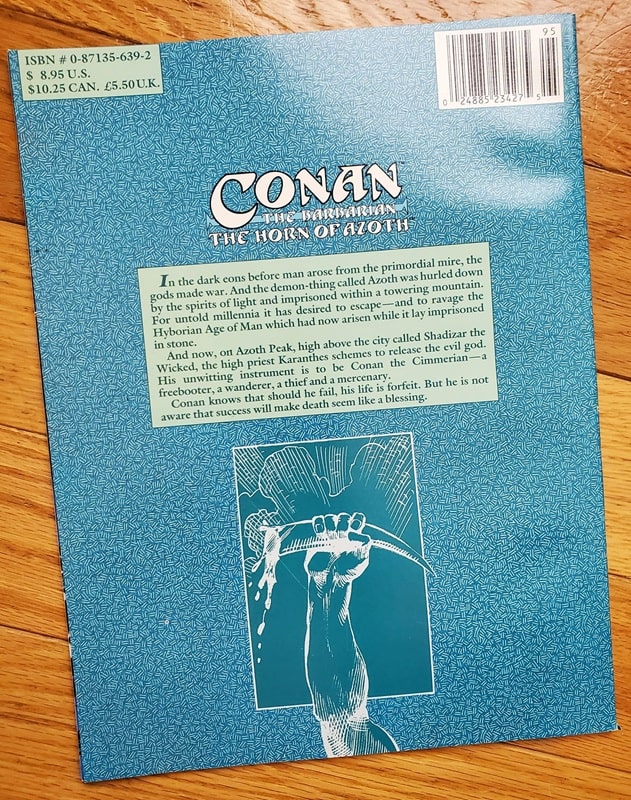 Back cover for Conan: The Horn of Azoth
Back cover for Conan: The Horn of Azoth
– Universal producer Pressman wanted it to be “lighter” (PG), so Thomas and Conway had to jettison some of their ideas. Result was their screenplay, Conan, King of Thieves.
– Pressman loved the screenplay, but sold his rights to Dino DeLaurentis.
– Dino was less familiar with REH and Conan, and he had his own ideas.
– The director, Donaldson, was removed. Dino wanted a lot of changes to the script. The storyline was continually adjusted.
– Dino hated leeches and rats and had them removed from the script. He wanted no stop-animation monster transformation, so the main monster had to be changed.
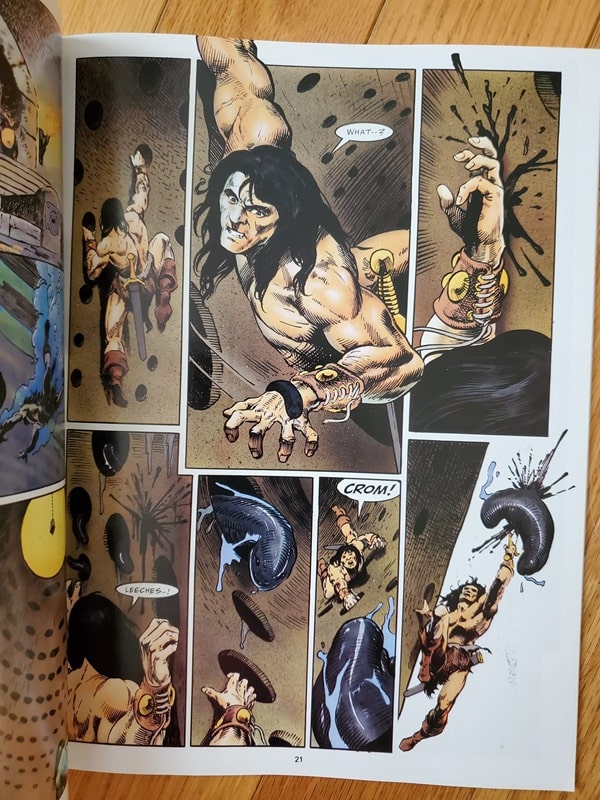
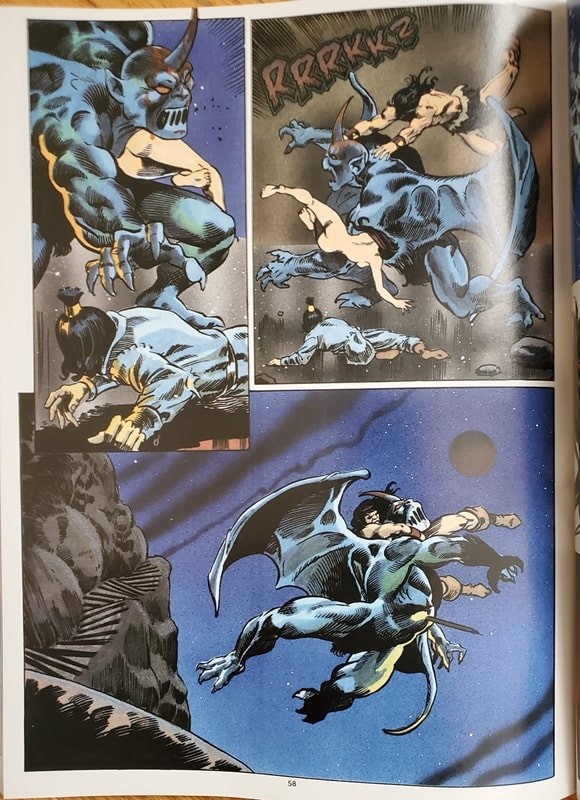
Interiors from The Horn of Azoth
– Richard Fleischer was hired as director. He came in with his own ideas and hired a new screenwriter to replace Thomas and Conway.
– Thomas and Conway had to fight for a screen credit in Conan the Destroyer. The Writers Guild decided that there were significant elements of the Thomas and Conway script that were retained, so they won.
– The original screenplay by Thomas and Conway was well-liked in the industry and led to further work for the two.
– Marvel editor Craig Anderson loved it, too, so they turned it from a 130-page screenplay to a 62-page graphic novel, published by Marvel.
And there you have it, Conan: The Horn of Azoth.
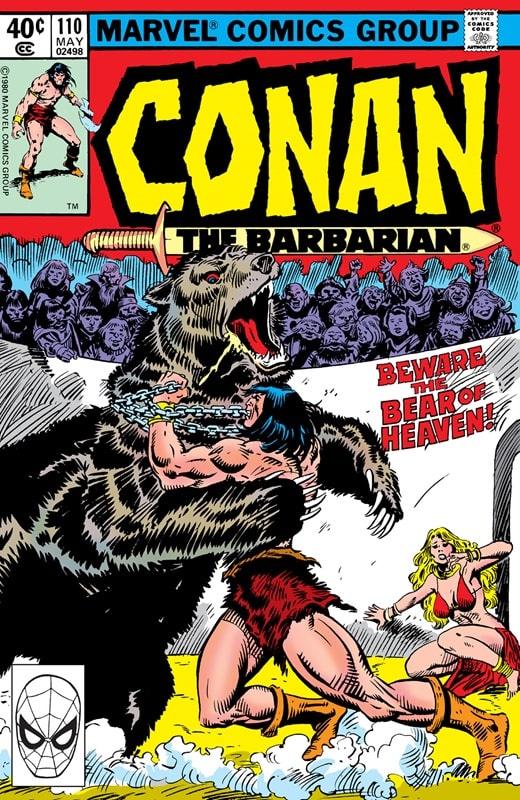 Conan the Barbarian #110, by Roy Thomas, John Buscema, and Al Milgrom (Marvel Comics, May 1980)
Conan the Barbarian #110, by Roy Thomas, John Buscema, and Al Milgrom (Marvel Comics, May 1980)
This is the first Conan the Barbarian comic that I ever read. Released in February of 1980 (with a cover date of May 1980), I would have been eight years old, soon to be nine.
I remember reading it over and over at my grandmother’s house, then redrawing it, too, making my own versions of Conan choking out a massive bear using a chain.
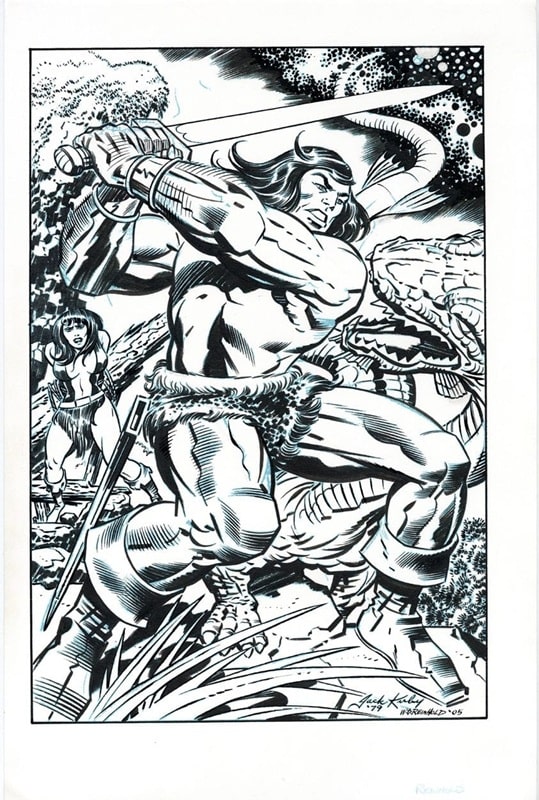 Conan by Jack Kirby
Conan by Jack Kirby
And here’s Conan the Barbarian, by Jack Kirby. Jack was not known for many Conan illustrations, but by Crom, this one is incredible.
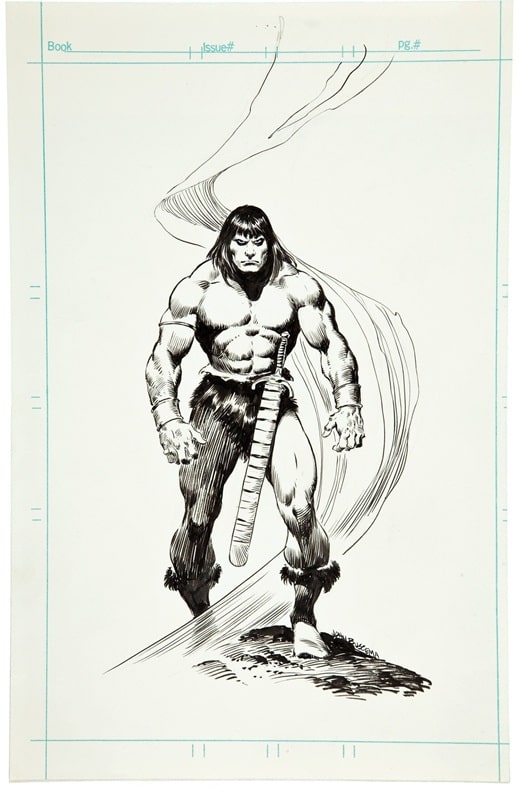 Conan by John Buscema
Conan by John Buscema
January 10, 2025 marked 23 years since the passing of the great John Buscema. His resume of artistic works is astonishing, to say the least, but for many of us (myself included), we will always remember him most for his Conan works (Conan the Barbarian, Savage Sword of Conan). When I read a Conan story (by REH or a pastiche author), and I picture Conan in my mind’s eye, I am seeing Big John’s rendition of the Cimmerian barbarian. Hail to John!
Jeffrey P. Talanian’s last article for Black Gate was The Intersection of Hobbies: Dungeons & Dragons, John Eric Holmes, and Tarzan. He is the creator and publisher of the Hyperborea sword-and-sorcery and weird science-fantasy RPG from North Wind Adventures. He was the co-author, with E. Gary Gygax, of the Castle Zagyg releases, including several Yggsburgh city supplements, Castle Zagyg: The East Mark Gazetteer, and Castle Zagyg: The Upper Works. Read Gabe Gybing’s interview with Jeffrey here, and follow his latest projects on Facebook and at www.hyperborea.tv.
Explore the Top 3 Rooftop Tents for Spring Camping 2025
As the weather warms up and nature beckons, spring camping becomes an enticing option for outdoor enthusiasts like you. Rooftop tents offer a unique way to experience the great outdoors, providing comfort and convenience while keeping you elevated and away from the ground. In this article, we will explore the top three rooftop tents for spring camping in 2025, helping you make an informed decision that enhances your outdoor adventures.
Top Picks- Best Overall: Naturnest Rooftop Tent – Andromeda Yellow – $999.00
- Best Value: Naturnest Rooftop Tent Hard Shell – Polaris 2 – $1,599.00
- Best for Families: Rooftop Tent Hard Shell – PEAKUNWIND – $1,999.00
When selecting the best rooftop tent for your spring camping needs, consider factors such as ease of setup, durability, weather resistance, and overall comfort. Each of these tents has been chosen based on their performance in these areas, ensuring you have a reliable shelter for your outdoor adventures.
Naturnest Rooftop TentThe Naturnest Rooftop Tent is your perfect companion for spring camping adventures. Designed for two, this tent offers a great view and excellent ventilation, making it ideal for stargazing or enjoying a gentle breeze while you relax. It’s lightweight at just 121 pounds, which means you can easily mount it on your vehicle without worrying about extra fuel consumption. Plus, it’s waterproof, windproof, and UV-resistant, ensuring you stay comfortable in various weather conditions. Whether you’re planning a weekend getaway or a longer road trip, this tent is a fantastic choice for both casual and serious campers.
What People SayUsers rave about the Naturnest Rooftop Tent’s ventilation and quality. Many appreciate how easy it is to set up and the comfort it provides, making it a favorite for outdoor enthusiasts.
-
My god, the ventilation and view of this tent are amazing. As you can see, it has doors and windows on all sides, and the top of the tent can also be opened. I drove to the suburbs and really tried to lie in the tent to see the stars. Guys, go outside and feel the nature. You will be grateful for it.
– GEORGE FREEMAN
-
I am impressed by the quality of this tent. The outer fabric is made of 420D Oxford cloth, which feels very thick and smooth, with no seam problems at all. It is completely waterproof, sun-proof, and completely blackout, providing a fully enclosed and safe interior space for outdoor camping.
– Julius Tayag
Pros:
- Excellent ventilation with multiple windows
- Lightweight design for easy transport
- High-quality materials ensure durability
Cons:
- Requires a vehicle with a roof rack for installation
- Great ventilation and view
- Lightweight and easy to install
- Durable and waterproof materials
Perfect for weekend camping trips, road trips, or even spontaneous outdoor adventures. The tent’s design allows you to enjoy nature without compromising comfort.
Current Price: $999.00
Rating: 5 (Total: 3+)
Naturnest Rooftop TentThe Naturnest Rooftop Tent is designed to elevate your spring camping experience. With a spacious layout for two, this tent not only provides a cozy spot to sleep but also offers stunning views and excellent ventilation. Weighing in at 185 pounds, it’s manageable for mounting on your vehicle, making it a practical choice for both weekend getaways and extended road trips. Plus, it’s built to withstand the elements—waterproof, windproof, and UV-resistant—so you can enjoy your adventures without worrying about the weather. Whether you’re stargazing or simply enjoying the fresh air, this tent is a fantastic addition to your outdoor gear.
What People SayUsers appreciate the Naturnest Rooftop Tent for its comfort and thoughtful design. Many highlight the ample storage options and the cozy mattress, making it a great choice for both casual campers and serious adventurers.
-
It is perfect for outdoor campers. It is very safe, the mattress is comfortable, the space is not too small, I think it can accommodate 2 people, it also has no condensation, and there are LED lights and multiple storage bags inside. Worth buying.
– lee jung ho
Pros:
- Comfortable mattress and spacious interior
- LED lights and storage bags enhance usability
- Durable construction for various weather conditions
Cons:
- Requires a vehicle with a roof rack for installation
- Spacious and comfortable for two
- Weather-resistant for all seasons
- Easy setup with thoughtful design features
This tent is perfect for weekend camping trips, spontaneous outdoor adventures, or even as a cozy retreat in your backyard. Its design allows you to enjoy nature comfortably, no matter where you are.
Current Price: $1,599.00
Rating: 5 (Total: 1+)
PEAKUNWIND Rooftop TentThe PEAKUNWIND Rooftop Tent is your go-to companion for spring camping adventures. With enough space for four people, this hard-shell tent is designed for comfort and convenience. Its Z-shaped design not only maximizes interior space but also ensures you can sit up comfortably without bumping your head. Setting it up is a breeze—just unlock the buckle, push up the ends, and let the air pressure rods do the work. Plus, it’s waterproof, UV-resistant, and built to withstand various weather conditions, making it perfect for both weekend getaways and longer trips. Whether you’re camping in the mountains or enjoying a night under the stars in your backyard, this tent is a fantastic choice.
What People SayUsers rave about the PEAKUNWIND Rooftop Tent for its spacious interior and hassle-free setup. Many appreciate the thoughtful accessories included, like the telescoping ladder and storage bags, which enhance the overall camping experience.
-
The Z-shaped design gives this rooftop tent plenty of space. I can sit and stretch without hitting my head, which is a huge plus. The extra room makes it perfect for longer trips.
– LEONARD W JOHNSON
Pros:
- Ample space for a comfortable camping experience
- Quick setup process saves time
- Includes useful accessories for convenience
Cons:
- Requires a vehicle with a roof rack for installation
- Spacious enough for four people
- Quick and easy setup
- Durable and weather-resistant materials
This tent is ideal for family camping trips, spontaneous adventures with friends, or even as a cozy escape in your own backyard. Its design allows you to enjoy the great outdoors comfortably, no matter where your travels take you.
Current Price: $1,999.00
Rating: 5 (Total: 3+)
FAQ What should I consider when choosing a rooftop tent for spring camping?When selecting a rooftop tent for spring camping, you should consider factors such as size, weight, and weather resistance. Ensure the tent can comfortably accommodate the number of people you plan to camp with. Look for lightweight options if you have a smaller vehicle, and prioritize tents with waterproof and windproof features to handle unpredictable spring weather. Additionally, check the setup time; a tent that can be easily assembled in under 10 minutes will save you time and hassle.
How do I maintain and care for my rooftop tent?To maintain your rooftop tent, regularly clean it with a mild soap and water solution to remove dirt and debris. Avoid harsh chemicals that could damage the fabric. After each use, ensure the tent is completely dry before packing it away to prevent mold and mildew. Store it in a cool, dry place when not in use. Additionally, inspect the seams and zippers periodically to ensure they are functioning properly and reseal them if necessary to maintain waterproofing.
Can I use a rooftop tent on any vehicle, and how do I ensure it fits my car?Not all rooftop tents are compatible with every vehicle, so it’s crucial to check the manufacturer’s specifications for compatibility. Most rooftop tents require a roof rack or crossbars that can support the tent’s weight. Ensure your vehicle’s roof can handle the combined weight of the tent and occupants. You can also consult with your vehicle’s manual or a professional to confirm the load capacity. If you’re unsure, consider visiting a local outdoor retailer for expert advice on fitting a rooftop tent to your specific vehicle.
Wrapping UpChoosing the right rooftop tent can significantly enhance your camping experience. The options highlighted in this article cater to various needs and preferences, ensuring that you can find the perfect fit for your adventures. Whether you prioritize comfort, value, or family-friendly features, these tents are designed to provide you with a memorable outdoor experience this spring.
Naturnest Rooftop Tent – Andromeda Yellow Naturnest Rooftop Tent – Polaris 2 Rooftop Tent Hard Shell – PEAKUNWIND

 Rating
5/5 (3 ratings)
5/5 (1 rating)
5/5 (3 ratings)
Highlights
Lightweight, waterproof, windproof, UV-resistant, 4-season tent for 2 persons.
Hard shell, easy setup, waterproof, windproof, UV-resistant, 4-season tent for 2 persons.
Hardshell, easy setup, blackout privacy, waterproof, UV-resistant, 4-season tent for 4 persons.
Pros
Excellent ventilation, great view, easy setup.
Comfortable mattress, spacious, no condensation.
Spacious interior, quick setup, sturdy design.
Cons
Higher price point.
Heavier than soft-shell options.
Most expensive option.
Price
$999.00
$1,599.00
$1,999.00
Buy Now
Buy Now
Buy Now
Rating
5/5 (3 ratings)
5/5 (1 rating)
5/5 (3 ratings)
Highlights
Lightweight, waterproof, windproof, UV-resistant, 4-season tent for 2 persons.
Hard shell, easy setup, waterproof, windproof, UV-resistant, 4-season tent for 2 persons.
Hardshell, easy setup, blackout privacy, waterproof, UV-resistant, 4-season tent for 4 persons.
Pros
Excellent ventilation, great view, easy setup.
Comfortable mattress, spacious, no condensation.
Spacious interior, quick setup, sturdy design.
Cons
Higher price point.
Heavier than soft-shell options.
Most expensive option.
Price
$999.00
$1,599.00
$1,999.00
Buy Now
Buy Now
Buy Now
The post Explore the Top 3 Rooftop Tents for Spring Camping 2025 first appeared on Rooftop Tents.
“The Lesson of the Master” and “The Master” | 2 Books in Conversation
Colm Tóibín, in his introduction to the 2007 edition of Henry James’ classic novella The…
The post “The Lesson of the Master” and “The Master” | 2 Books in Conversation appeared first on LitStack.
UNHALLOWED HALLS by Lili Wilkinson
Midnight Rambles: H.P. Lovecraft in Gotham by David J. Goodwin
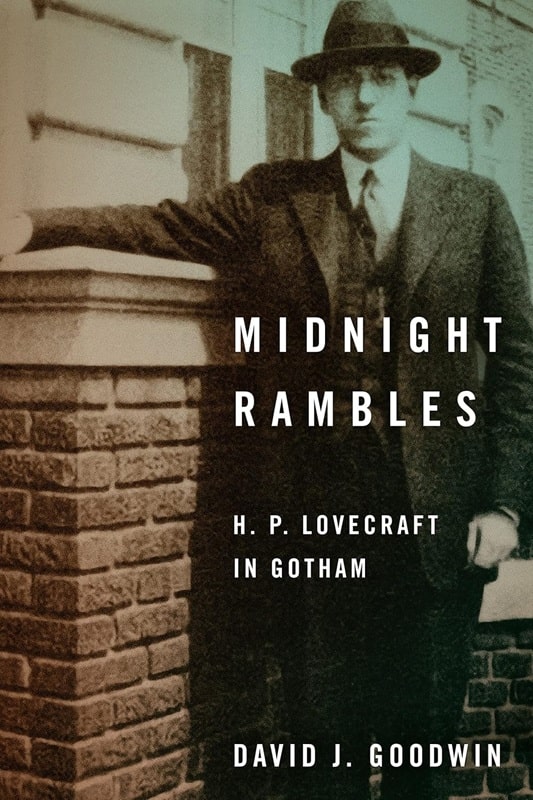
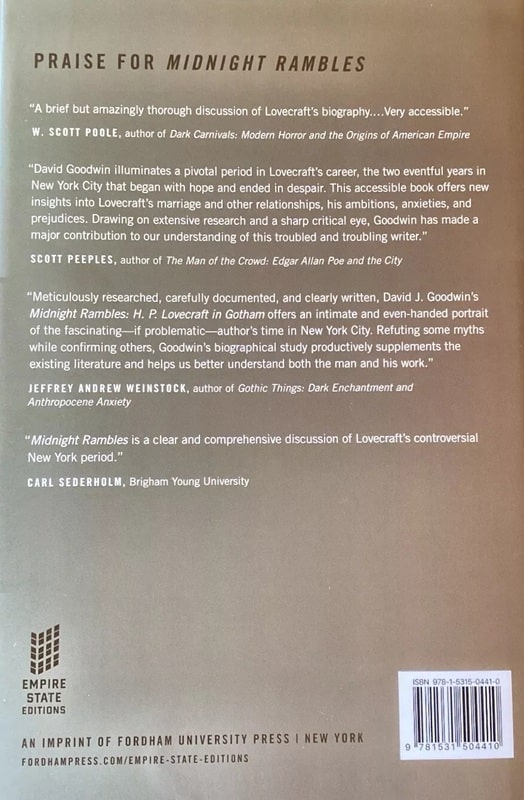
Midnight Rambles: H.P. Lovecraft in Gotham (Empire State Editions, November 7, 2023)
David J. Goodwin’s Midnight Rambles: H.P. Lovecraft in Gotham provides a narrow and deep slice of H. P. Lovecraft’s biography, detailing his personal and professional life during the few years he lived in New York City. Deeply researched and full of connections, Goodwin provides correction to some long-held Lovecraft biographical details and does not flinch from detailing Lovecraft’s innate hostility to non-WASP groups, ably describing it in the context of a deeply racist and anti-semitic society.
There are very few people who can claim to be expert on the life and work of H.P. Lovecraft, and Goodwin’s book puts him in range of that small number (such as S.T. Joshi). As he’s written and presented about Lovecraft more than half a dozen times, Goodwin seems poised to rise to stand among the critics named when the storied and controversial author rises in conversation, if he’s not there already. Learn more about Goodwin here.
Goodwin faces a difficult biographical subject in writer H.P. Lovecraft. Much material of signal importance during this time is unavailable. His spouse, Sonia Greene, destroyed some 400 of Lovecraft’s letters, largely from the period of interest for this text. Lovecraft’s aunts, demonstrably hostile to his marriage to Greene, discarded dozens of postcards when Lovecraft moved to New York through the simple expedient of giving away everything he had not specifically requested be sent to his new lodgings in the city. These details sample the rich trove of information about Lovecraft in Goodwin’s text.
Despite these holes in the biographical record, Goodwin’s ample research buttresses his assertions about the writer’s experiences in Gotham. The period constitutes a fertile time for Lovecraft, a locus that saw the invention of what would later be called the Cthulhu mythos. That it also saw the creation of the author’s least palatable, racist fiction represents an unavoidable truth. For each of the Lovecraft stories written during his residence in the city, Goodwin provides detailed research that helps illuminate the influences likely to have pressed upon the author. However, the biographer also includes historical demographic information to fully contextualize the lack of basis for any of Lovecraft’s many claims, a thread illustrating Lovecraft’s self-mythologizing nature.
The architecture of houses, the urban design of towns and cities was always of interest to Lovecraft, who, Goodwin explains, ambled extraordinary distances to view places and structures of interest. Readers familiar with John Crowley’s Little, Big may notice a reference to a real life builder important to New York that appears in that fictional text.
Lovecraft’s relationship with Sonia Greene merits several chapters and encapsulates their meeting, courtship, sudden marriage, and ultimate divorce that neatly marks the end of Lovecraft’s time in the city. Goodwin works wonders with the limited material available on this window to the past and readers familiar with Lovecraft biographies of broader scope will find material of interest in these pages. It is here Goodwin provides the price of admission for this text. Owing to an absence of a signed decree of divorce, past biographers have stated the author failed to sign those papers, meaning Greene’s subsequent marriage in California was bigamous.
Goodwin effectively implodes this “never signed” myth with solid evidence to the contrary, noting in addition that the loss of legal documentation was not uncommon in the 1920s. This conclusion is an exception among many assertions buttressed with the language of guesswork. Of all the guesses in Midnight Rambles, none struck this reviewer as unlikely or a reach. The biographer confines himself to likely scenarios, allowing for the many connections to form a compelling web to wrap these Lovecraft years for readers.
Readers interested in Lovecraft will find Midnight Rambles required reading. In this readable and at the same time admirably academic work (the two do not always meet amicably) even casual readers of Lovecraft may find information of interest. While Lovecraft expressed vehement racist and anti-semitic views, he married a Jew. While holding typical for the era dislike for homosexuals, one of his New York City walking buddies and long time correspondent was gay. Understanding this author, who some say serves as the pennant-waver for American horror fiction in sequence after Edgar Allan Poe, is made easier by Goodwin’s work. I recommend it to Lovecraft enthusiasts and any who find interest in the literary history of Gotham, our style and fashion capital.
Edward Carmien’s last article for Black Gate was When Your First Language is Role-Playing Games. His short stories “Before the Wind” and “Knives Under the Spring Moon” appeared in the print version on Black Gate in 2007 and 2008. He maintains a daily blog on writing at edwardcarmien.wordpress.com
Sorcery & Small Magics by Maiga Doocy
YA / Fantasy
Leovander Loveage is a bit of a failure as a scryer. While other sorcerers are writing powerful and complex spells he is stuck writing small magic. His exact opposite is the intensely serious Sebastian Grimm. He is a magical prodigy…and they hate each other.
Until they are forced to partner in class. Leovander hands Grimm a spell to cast on him but the small magic he thought was being cast was somehow mixed up with a powerful curse. And they must somehow put aside their differences to break the curse.
I try to not compare books but I’m going to here. Sorcery & Small Magics gave me some of the same feelings as Darkwood by Gabby Hutchinson Crouch. Honestly that’s about the highest praise I can think of. I loved this book and I’m excited for the series to continue.

A Sorceress Comes to Call - Book Review
 A Sorceress Comes to Callby T. Kingfisher
A Sorceress Comes to Callby T. KingfisherWhat is it about:A dark retelling of the Brothers Grimm's Goose Girl, rife with secrets, murder, and forbidden magic
Cordelia knows her mother is unusual. Their house doesn’t have any doors between rooms, and her mother doesn't allow Cordelia to have a single friend—unless you count Falada, her mother's beautiful white horse. The only time Cordelia feels truly free is on her daily rides with him. But more than simple eccentricity sets her mother apart. Other mothers don’t force their daughters to be silent and motionless for hours, sometimes days, on end. Other mothers aren’t sorcerers.
After a suspicious death in their small town, Cordelia’s mother insists they leave in the middle of the night, riding away on Falada’s sturdy back, leaving behind all Cordelia has ever known. They arrive at the remote country manor of a wealthy older man, the Squire, and his unwed sister, Hester. Cordelia’s mother intends to lure the Squire into marriage, and Cordelia knows this can only be bad news for the bumbling gentleman and his kind, intelligent sister.
Hester sees the way Cordelia shrinks away from her mother, how the young girl sits eerily still at dinner every night. Hester knows that to save her brother from bewitchment and to rescue the terrified Cordelia, she will have to face down a wicked witch of the worst kind.
What did I think of it:I've read several book by T. Kingfisher and loved them all. Still I kept mostly to her more horror-like books, with A Wizard's Guide to Defensive Baking the exception. I also had two more of her horror titles in my TBR when I received this book as a present. It had been on my radar (even had it in my greedy trotters when birthday shopping, but decided on another book), and the copy that I got was so pretty, and it had geese on the end-papers! So I immediately moved this to the top of TBR mountain.
And what a gorgeous, beautiful, amazing read!
This is a re-imagining of the faerie tale The Goose Girl. And it certainly has things that I recognize from the faerie tale, but mostly this is so much its own totally amazing story!
You get the story told from a couple of different viewpoints, mainly Cordelia and Hester.
I really liked Cordelia and felt for her. Her mother is a character I disliked and grew to hate the more I learned. I wanted Cordelia to find happiness.
I totally loved Hester! In her early 50's she has to deal with people thinking she's old, a bad knee, and her own insecurities. She also used to breed geese! I rooted for her even more than for Cordelia I can tell you.
(Voodoo Bride again wants me to add she really loved one of the male characters, and she says she wants a Richard of her own. Everyone needs someone like him in her opinion.)
There were several really cool other characters, and with how things were going I feared for a lot of them with good reason. This might be a retelling and not a horror story, there were enough bad things happening to keep me on edge.
After finishing this I had to take a breather before picking up my next book as I was still full of this one. You bet this will be reread and treasured! I will pick up one of the other Kingfisher books in my TBR soon.
Why should you read it:It's Absolutely Amazing!
Book Review: Grave Empire by Richard Swan
I received a review copy from the publisher. This does not affect the contents of my review and all opinions are my own.
Mogsy’s Rating: 4.5 of 5 stars
Genre: Fantasy
Series: Book 1 of The Great Silence
Publisher: Orbit (February 4, 2025)
Length: 529 pages
Author Information: Website
The Empire of the Wolf trilogy was one of the best and most compelling fantasy series I’ve read in years, so naturally I could not wait to get my hands on the next book by my newest favorite author Richard Swan. And with Grave Empire, Swan proves once more his talent in blending gripping storytelling with deep worldbuilding and complex political intrigue.
Though set in the same universe as the author’s previous series, this first volume of The Great Silence trilogy takes place many years later. So much time has passed that society in Sova has evolved onto the cusp of an industrial revolution, pushing the use of magic into the shadows. The world is changing, and with it, the balance of power is shifting. The story is told through the eyes of three main characters, each navigating their own path in this era of upheaval, unsure how their roles will shape the future.
First, we meet Renata, a junior ambassador to the mysterious mer-people of Stygia, whose routine is disrupted when her office is approached by two traveling monks from a death-magic sect, bringing dire warnings of the “Great Silence.” This is a prophecy that warns of an impending catastrophe—beginning with the inability to communicate with the spirits in the afterlife, signaling the end of the world. Realizing that this can have far-reaching consequences for all civilizations and not just the Sovans, Renata joins others on a diplomatic mission to seek guidance from the Stygion magic users, hoping to prevent the disaster from happening. Meanwhile, Peter is an inexperienced officer who receives a commission to lead a group of soldiers through wild and uncharted territory, which some even say is cursed. Stationed at the very edges of the empire, he and his troops face an unearthly enemy they are wholly unprepared for—one that invades the mind and makes you question everything you see or hear. And finally, we have Count Von Oldenburg, an ambitious and ruthless noble who harbors an obsession with anything to do with the arcane. With the reluctant help of his lover, he secretly conducts horrific experiments in his home involving dangerous and outlawed magic.
With the threat of apocalypse looming, our characters’ choices will determine whether the empire survives or falls. The main conflict of Grave Empire is the potential chaos the Great Silence could bring, though it does take a while for the connection between the three threads to be revealed. I found my time with each character compelling in their own way, each offering a unique perspective on events from their individual spheres of influence.
Renata’s chapters, for example, were steeped in political tension and diplomatic maneuvering, and she even survives an assassination attempt. In addition, there’s her personal struggle to gain respect in her role, one made all the more difficult by the near-mythological status of the mermen. Watching her journey unfold, from dealing with mockery to her eventual firsthand encounter with the merfolk, was one of the novel’s most rewarding aspects.
Peter, in contrast, is a very different kind or protagonist—one completely out of his depth who is attempting to lead a group of soldiers who neither respect or trust him. The letters to his father which precede each of his chapters reveal a scared young man filled with self-doubt. And when his unit finally comes face to face with the enemy, the results are grim, brutal, and disturbing.
Then there’s Von Oldenburg, who hears “grim, brutal, and disturbing” and says, “hold my beer.” In terms of page time, he had the least presence, yet his character had the most visceral impact. His twisted logic and relentless pursuit of knowledge make for an unsettling character study as he continually pushes ethical boundaries under the guise of scientific progress. His relationship with his mistress Yelena is another point of intrigue—complex, difficult to define, and layered with personal history which adds another fascinating level of depth to his chapters, even though he himself is a vile person.
Though reading the previous trilogy is not required, it was also exciting for me to see how the world has changed since the events at the end of Empire of the Wolf. We have moved into an industrial age where technological advancements reign supreme, and gunpowder appears to be the way of the future. However, the setting retains Swan’s signature mix of dark fantasy worlds populated by morally gray characters. Everything feels like they are in a state of flux, painting a picture of a society on the brink of transformation, being pulled in many different directions at once by love of tradition, hunger for power, and the fear of the unknown.
Swan’s prose is both atmospheric and accessible, which made it easy for me to immerse myself in Grave Empire. Written in the third person, we gained the ability to follow multiple characters across the empire, allowing us to explore more areas of Sovan society and beyond. Because of this, though, we do lose some of the intimacy of the first-person narrative, which was used for Empire of the Wolf. That might be my only regret here, as the three character POVs did not convey as much immediacy as I would have liked, and the connections between them were also not as apparent. The themes of the book are also very dark, without much levity, which made this a relatively slower, heavier read.
Nevertheless, by the end of the book, I was completely sold on its new plot conflicts and characters. The slow build ultimately pays off as the stakes rise become further entangled in the fate of the empire. Grave Empire is not going to be an easy or light read, but for fantasy fans who appreciate intricate storylines and deep character work, Richard Swarn delivers another stellar novel that is both thrilling and thought-provoking. With so many secrets still to unravel and mysteries to solve, I’m looking forward to seeing where the series goes next.
![]()
![]()
Goth Chick News: Throwback Thursday – When Mickey Rourke Met Lucifer
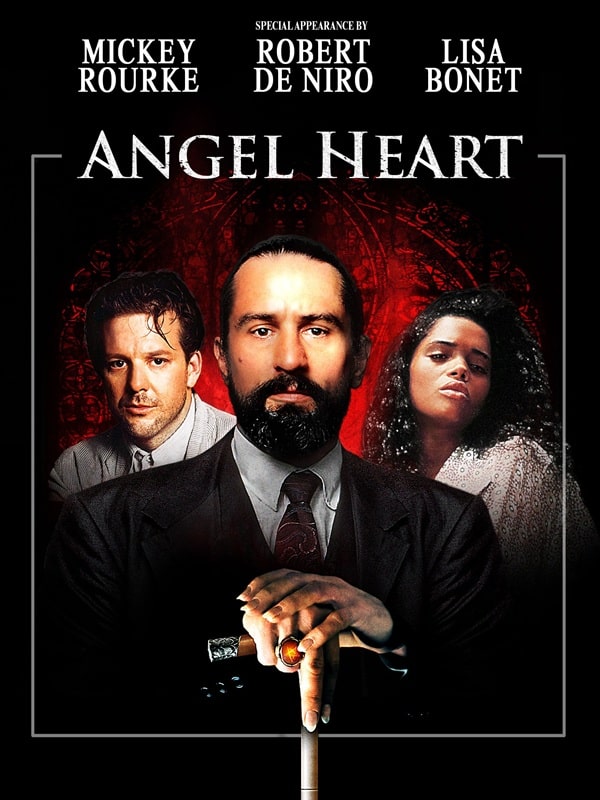 Angel Heart (Tri-Star Pictures, March 6, 1987)
Angel Heart (Tri-Star Pictures, March 6, 1987)
This is how my brain works sometimes.
This week Deadline reported that Robert De Niro will be starring in an upcoming crime drama for Netflix called The Whisper Man based on a novel by the same name. That made me think that when I last saw De Niro, the dude looked pretty old, and that starring in a multi-installment series for Netflix would be pretty taxing. That led me to IMDB to find out how old he really is (De Niro is 81), which resulted in going down the rabbit hole of his incredible career, which led me to Angel Heart (1987).
I had all but forgotten about this film, but the minute I read the name all this controversial stuff about it started resurfacing in my mind. Honestly, I couldn’t recall if Angel Heart was really all that controversial, or if I remembered it wrong and naturally this resulted in a lost afternoon reading everything about it I could get my hands on.
So, here we are and yes, the movie was steeped in controversy.
 Mickey Rourke and Lisa Bonet in Angel Heart
Mickey Rourke and Lisa Bonet in Angel Heart
Directed by Alan Parker (Midnight Express) and starring the pre-cosmetic surgery hotness that was a young Mickey Rourke, Robert De Niro, and Lisa Bonet (one of those adorable Cosby Show kids), Angel Heart blended the genres of psychological thriller, neo-noir, and horror. Set in 1955 New Orleans, it tells the story of small-time private investigator Harry Angel (Rourke) who is hired by a man who calls himself Louis Cypher (De Niro) to track down a singer named Johnny Favorite.
The investigation takes Angel into the backwaters of the Louisiana bayou where he meets the luscious young Epiphany Proudfoot (Bonet), who also happens to be a voodoo priestess. Suddenly, the trail Angel is following becomes soaked in blood and gruesome murder. So, who is trying to keep Angel from finding his quarry?
To kick off the reasons Angel Heart became a cult classic, after it pretty much bombed at the box office, was that at the time Bonet was best known for her role as Denise Huxtable on The Cosby Show, a wholesome family sitcom. Bonet’s Angel Heart performance included a graphic sex scene and nudity, which led to backlash for her career and to her public image.
Though it didn’t exactly ruin her in Hollywood, Angel Heart made it challenging for Bonet to find roles that matched her previous success. Producers and casting agents often pigeonhole actresses based on public perception, and Bonet’s decision to take on such a provocative role led to her being seen as “too edgy” for mainstream projects (for another example, seee Elizabeth Berkley [Saved by the Bell] and her movie Showgirl [1995]).
While we’re on the topic of sex scenes, the most infamous Angel Heart controversy involved the raw sex scene between Rourke and Bonet. This scene, which featured nudity, blood, and disturbing imagery, pushed boundaries for its time, not the least of which was because of the revelation of an incestuous relationship between Rourke’s and Bonet’s characters. This plot twist, coupled with the explicitness of the scene, sparked outrage and made the film even more polarizing.
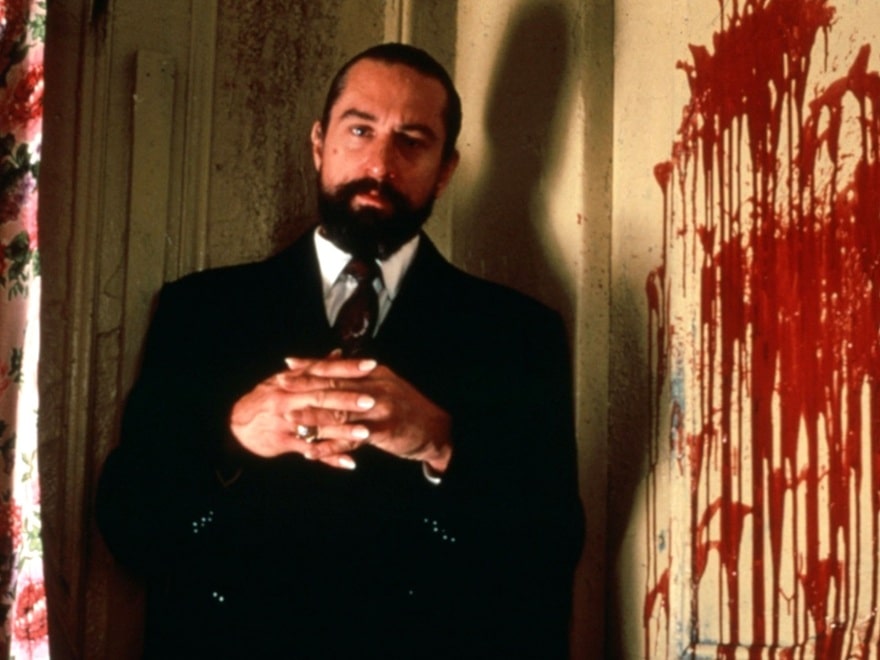 Robert De Niro as Louis Cyphre
Robert De Niro as Louis Cyphre
The film’s depiction of voodoo practices, combined with De Niro’s portrayal of Louis Cyphre (an alias for Lucifer if that hasn’t jumped out at you yet), upset religious groups to no end. De Niro’s performance, though praised by audiences for its eerie subtlety, drew vocal criticism for allegedly glamorizing the devil. Critics accused Angel Heart of promoting occultism and blasphemy, while others argued that the film perpetuated stereotypes about voodoo and Haitian culture, painting them as sinister or evil.
Then there was the violence. Angel Heart is graphically violent, with several brutal and unsettling death scenes, including one involving a character’s heart being ripped out and another being boiled alive in a large vat of jambalaya. The overall dark tones and the depiction of psychological torment left many viewers disturbed, especially as Harry Angel’s true identity and fate are revealed.
The Motion Picture Association of America (MPAA) initially gave the film an X rating. Alan Parker had to cut approximately 10 seconds of footage from Bonet and Rourke’s nude romp to secure an R rating, though many still found the final version shocking. Ironically all the goriest scenes remained intact. You’d never imagine De Niro eating a hard-boiled egg could be so unnerving.
 Mickey Rourke then and now
Mickey Rourke then and now
Yes, I immediately had to give Angel Heart a rewatch – it’s pretty much streaming everywhere. Frankly, I’ve always liked it in the same way I’ve always liked The Ninth Gate (1999) with Johnny Depp. Just suspend your disbelief and go there, provided you can get around the distraction of how the actors have changed (not just aged) in the years since.
Spotlight on Enthralling “Once Was Willem” by M. R. Carey
Mark your calendars, LitStackers! Once Was Willem by M. R. Carey is in presale (the…
The post Spotlight on Enthralling “Once Was Willem” by M. R. Carey appeared first on LitStack.
On McPig's Wishlist - Paladin's Grace
 Paladin's Grace (The Saint of Steel #1)by T. Kingfisher
Paladin's Grace (The Saint of Steel #1)by T. KingfisherStephen's god died on the longest day of the year…
Three years later, Stephen is a broken paladin, living only for the chance to be useful before he dies. But all that changes when he encounters a fugitive named Grace in an alley and witnesses an assassination attempt gone wrong. Now the pair must navigate a web of treachery, beset on all sides by spies and poisoners, while a cryptic killer stalks one step behind…
From the Hugo and Nebula Award winning author of Swordheart and The Twisted Ones comes a saga of murder, magic, and love on the far side of despair.
A Masterful Three Novella Original Anthology: The New Atlantis, edited by Robert Silverberg
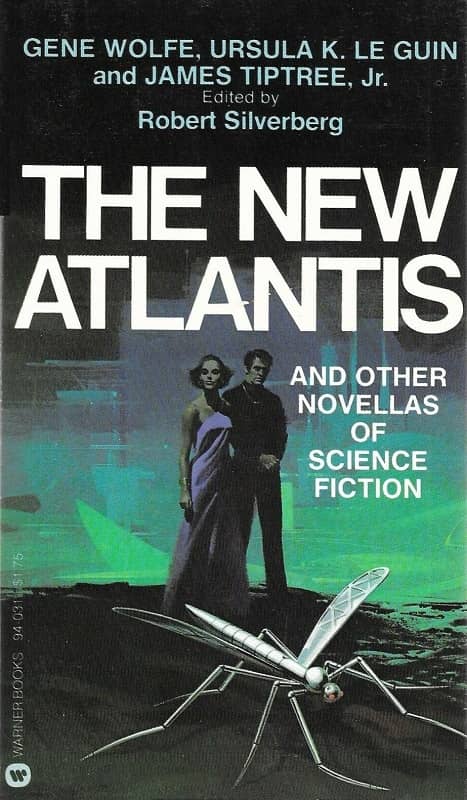
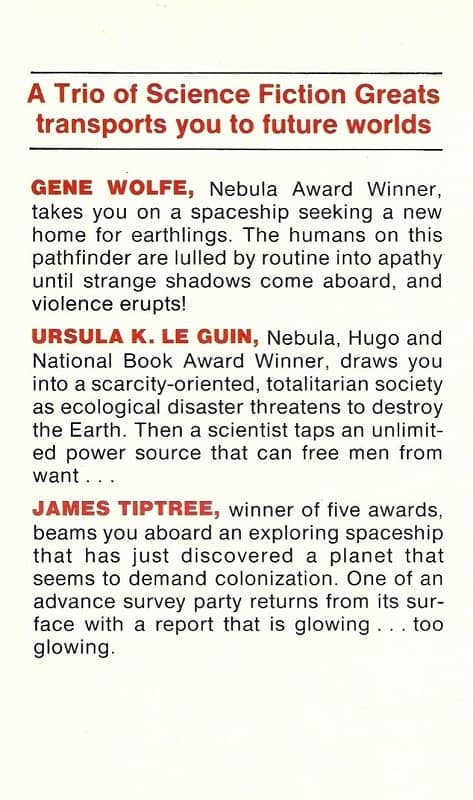
The New Atlantis (Warner Books paperback reprint, 1978). Cover by Lou Feck
My latest look at a book from the 1970s treats a major anthology from 1975. The New Atlantis and Other Novellas collects three long stories: “Silhouette,” by Gene Wolfe; “The New Atlantis,” by Ursula K. Le Guin, and “A Momentary Taste of Being,” by James Tiptree, Jr. The project received plenty of notice at awards time – the book as a whole was fifth in the Locus Poll for Best Anthology, “A Momentary Taste of Being” and “Silhouette” were 7th and 9th, respectively, in the Locus Poll for Best Novella, while “The New Atlantis” won the Locus Poll for Best Novelette, and received a Hugo nomination in that category, and both it and the Tiptree also got Nebula nominations.
Let’s look at the individual stories first.
“Silhouette” by Gene WolfeGene Wolfe was a remarkable writer at all lengths — he produced brilliant short-shorts, short stories, novelettes, novellas, novels, series of novels, even a series of series of novels. “Silhouette,” at about 20,000 words, is one of his novellas — and it may be that the novella was his ideal length.
[Click the images for masterful versions.]
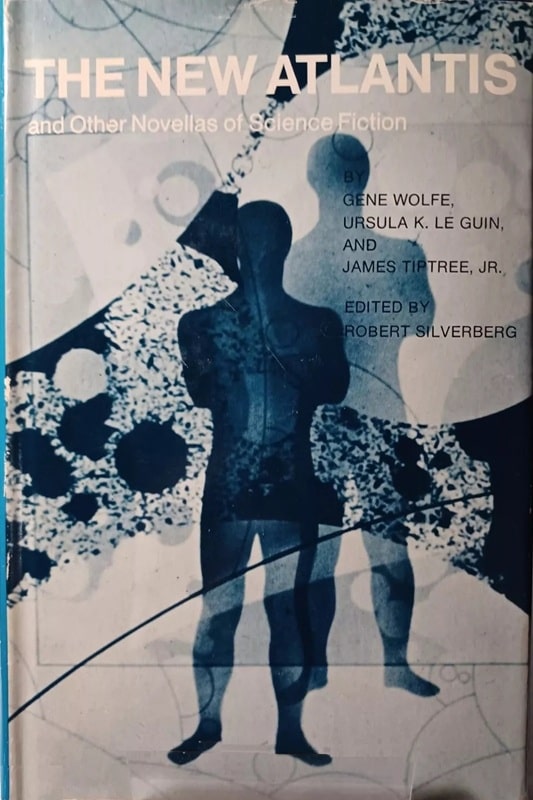 The New Atlantis hardcover edition (Hawthorn Books/Science Fiction Book Club, 1990). Cover by Jorge Hernandez
The New Atlantis hardcover edition (Hawthorn Books/Science Fiction Book Club, 1990). Cover by Jorge Hernandez
At any rate he wrote some 15 novellas, ranging from “The Fifth Head of Cerberus” in 1972, to “Memorare” in 2007; and of these at least “The Fifth Head of Cerberus,” “The Death of Dr. Island,” “Tracking Song,” “The Eyeflash Miracles,” “Seven American Nights,” and “The Ziggurat” rank among the great novellas in SF history. I don’t rank “Silhouette” quite with those stories, but it is a powerful and original piece.
A starship has reached a planet called Neuerrdraht, and the crew are considering whether it is suitable for human habitation. The viewpoint character is Johann, one of the officers, who is skeptical about the prospect of colonization. The ship is deteriorating, however, and the Captain is insistent. There are other factions, including a group that worships the ship’s computer… We get a flavor of life on the ship — a certain grunginess, oppressiveness, with features such as women (except for the Captain) being required to sleep with officers whenever available. Johann has dreams of walking on the surface of the planet, and he is visited by a — shadow? his shadow? something from the planet? A silhouette, at any rate!
The story continues in a disturbing fashion, as the atmosphere on the ship becomes darker. There’s a sense that the ship’s decay mirrors the decay on Earth, from which they had escaped. Johann finds himself confronting the computer-worshippers, and a group that seems intent on mutiny, and people ready to hurt him if he won’t cooperate. With the ambiguous help of the shadow being, he gets through all this, and then comes the actual mutiny, with chaotic and unexpected results.
This is a very good story, but as I said not quite Wolfe at his best. It lacks the truly mysterious aspect that I love most in Wolfe’s work. As I suggest above, I think the best way to read it is to see conditions on the ship as a sort of metaphor — a reflection, even a silhouette — of conditions on the Earth they left. The ship is full of class divisions, and sexual divisions: it’s a particularly oppressive place for women, it seems. And there is no reason to expect colonizing Neuerrdraht will solve anything.
“The New Atlantis” by Ursula K. Le GuinThis is the shortest of these stories, at perhaps 10,000 words. It is set in a ruined near future (to 1975) US, in which climate change has caused sea levels to rise and some parts of the coast are submerged. The country is ruled by a sort of corporatist tyranny, which to my eyes had both right-wing and left-wing elements. The narrator lives in Portland, and her husband has just returned from a prison camp — but they have to be careful, as in this future marriage is illegal. She is a musician, and her husband is a mathematician. And there are rumors of new continents emerging from the ocean.
The narrative alternates passages in the narrator’s POV, with passages from the POV of a mysterious underwater being. The narrator tells of ordinary life in this dismal future: practices her music in the bathroom to frustrate the bug they discovered there, and her husband has friends over, talking dangerously about politics and also about science — in particular, a discovery they have made of a very cheap and portable energy source. The corporatist rulers have a monopoly on energy, and there isn’t enough available to most people. Free energy will be wonderful but destabilizing to the government. . Meanwhile, the sea level keeps rising, and her husband’s risks are clearly threatening their life together. All along the underwater being is telling of what it witnesses, and it’s more or less clear that this is an entity on the rising continent.
The conclusion is mournful, ultimately. There is a sense — ambiguous perhaps — that humanity has irretrievably messed up the planet, and that the “New Atlantis,” which might have been a new sanctuary perhaps? 0r might represent a purified world? — will either be empty or available for humanity’s successors. (But really that’s my speculation purely.)
It’s obvious that aspects of this story seem prescient now, though the story certainly isn’t (and wasn’t trying to be) an accurate prediction of our times. It’s more of an impressionistic, and somewhat despairing, depiction of a decay Le Guin foresaw. And it’s beautifully written.
“A Momentary Taste of Being” by James Tiptree, Jr.This story is by far the longest story here, at some 37,000 words, occupying well over half the book. The setup is curiously similar to that of Wolfe’s “Silhouette”: a starship, the Centaur, has come from a ravaged Earth hoping to find a suitable planet to colonize. As the ship’s name suggests, the solar system being investigated is Alpha Centauri, and as the action opens, Dr. Lory Kaye is in quarantine, having just returned from an expedition to a promising planet. She returned alone, leaving the fellow members of the expedition on the planet, which seems to be a wonderful place, in her telling. She has also brought back a sample of alien life, a large plant-like being. Her ship, and she herself, are quarantined. The story is told from the POV of her brother, Dr. Aaron Kaye, the chief medical officer.
Lory’s tale is received suspiciously by some of the officers. There is minimal actual data retrieved from the planet. There are some hints of what seems to have been violence, or at least disagreements between the various planetary explorers. And there seem to be strange effects on everyone who gets anywhere near the alien plant. But everyone is exhausted by their long mission (10 years) and there is a sense that this is the last chance for the people of Earth. Aaron himself is one of the more skeptical about the planet’s prospects, as is their alcoholic captain. But others desperately want to immediately colonize the planet and send a signal to Earth for others to follow. One man tells Aaron of his plans to set himself up as a sort of petty ruler, complete with an harem (that would include Aaron’s lover Solange.) Aaron, too, is torn by his loyalty to his sister, with whom he had an extended incestuous relationship through their teens.
The story is a rather a slow burn — with a very extended telling of the final day or so of Lory’s quarantine, and of the plans to study the alien plant she brought back; as well as some flashback to Aaron and Lory’s past, and depictions of Aaron’s interactions with other crew members, including a horribly injured man named Tighe, as well as Captain Yellaston, whose alcohol is supplied by Aaron; and the various other officers with their motivations, and descriptions of the somewhat unstable mental state of just about everyone.
But it all culminates in a really powerful final scene, as the nature of the alien plant creature is revealed, and Tiptree’s metaphor for what is really going on becomes clear. It’s a very Tiptree-like ending, and, like so many of her stories, it’s fundamentally about sex and death. Part of me wishes it was somewhat shorter, but perhaps the drawn out beginning is necessary to set up the conclusion. It’s not Tiptree’s greatest story, but it’s one of her most characteristic, I think, and it’s really despairingly effective. Tiptree’s vision, it seems to me, never exactly sunny, became darker and darker throughout the ’70s, culminating in 1980 with “Slow Music,” often called her last great story.
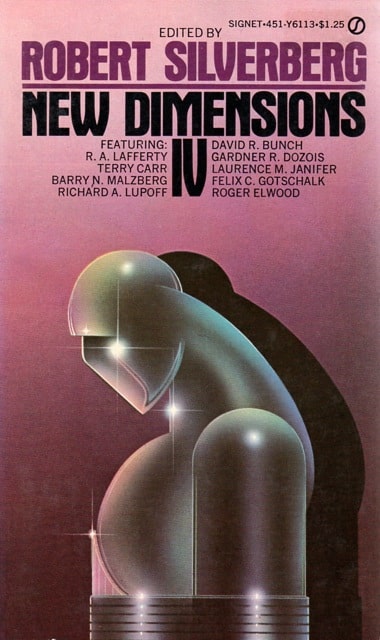
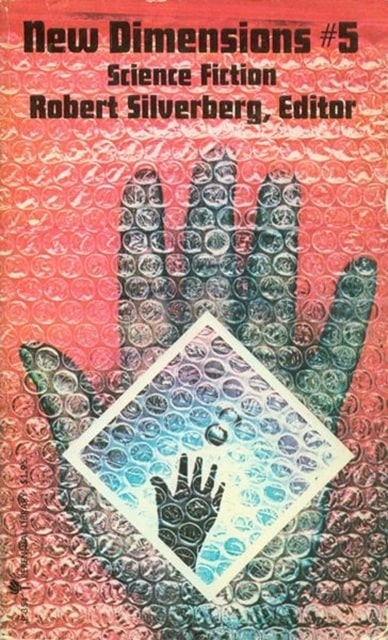
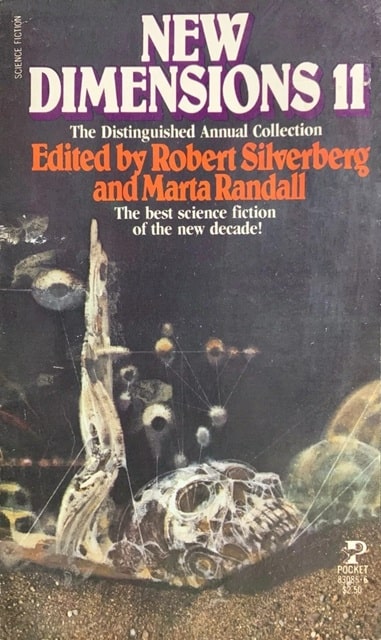
Three volumes of Robert Silverberg’s New Dimensions: IV (Signet, October 1974),
5 (Perennial Library, September 1976), and 11 (edited with Marta Randall,
Pocket Books, July 1980). Cover art: unknown, Joe Harris, Richard Powers
This anthology highlights an aspect of Silverberg’s career for which he perhaps hasn’t gotten the credit he deserves: his influence on SF as an editor and anthologist. And it is possible that the single best original anthology Robert Silverberg produced was this one — The New Atlantis. The three stories are by three of the greatest SF writers of all time, each at the absolute height of their powers. (And, as Silverberg notes in his introduction, all three of these writers came to SF fairly late.)
Silverberg’s editorial contributions go well beyond this book. His original anthology series New Dimensions is remarkable as well, featuring a great many of the best stories of its time. The massive original anthology Epoch (co-edited by Roger Elwood) was far better than its Elwood-stained reputation suggests. He produced many more original anthologies (see sidebar below).
He was also a prolific anthologist of older stories, most notably The Science Fiction Hall of Fame, Volume I, and a wonderful set of 7 books called Alpha. He published quite a few more short anthologies of older SF, and some later doorstops, both original (as with the Legends books, and Far Horizons, plus three books following on the late Terry Carr’s Universe series that he co-edited with his wife Karen Haber), and also reprint books, particularly two Arbor House collections of Great Short Stories and Great Short Novels.
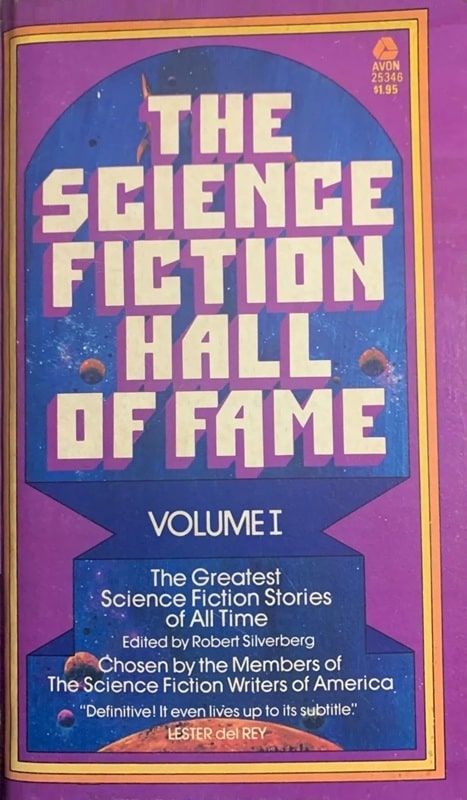
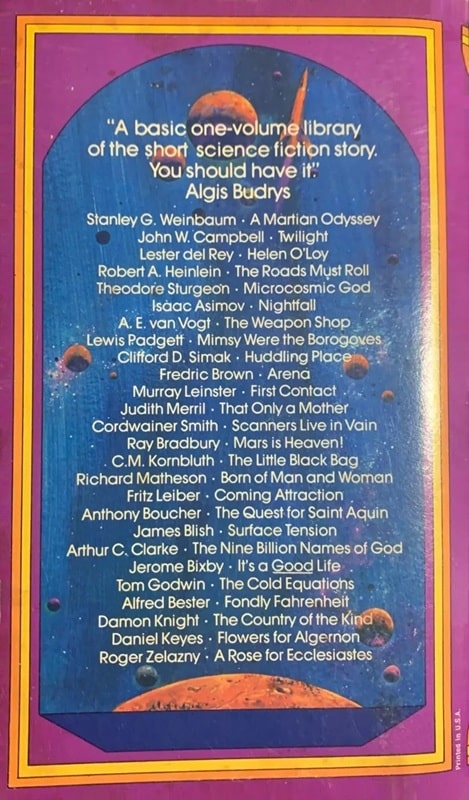
The Science Fiction Hall of Fame, Volume I, edited by Robert Silverberg (Avon, July 1971).
In the decade from 1969 to 1979, Robert Silverberg edited 11 anthologies of original novellas. (One book had four stories.) At the same time Silverberg was producing his original anthology series New Dimensions, and his reprint series Alpha. And that’s not to mention his own fiction — despite a retirement during this period he published some 15 novels and dozens of short stories.
Relatively few examples in the three novella format come from other editors. Silverberg’s primary rival (as I perceive it), Terry Carr, did just one “three novella” book, though a very good one, An Exaltation of Stars. The super prolific Roger Elwood published three, Futurelove, A World Named Cleopatra (with Poul Anderson), and In the Wake of Man. That last book, which had stories by R. A. Lafferty, and Walter F. Moudy, is one of Elwood’s very best, particularly as it features one of Gene Wolfe’s greatest novellas, “Tracking Song.”
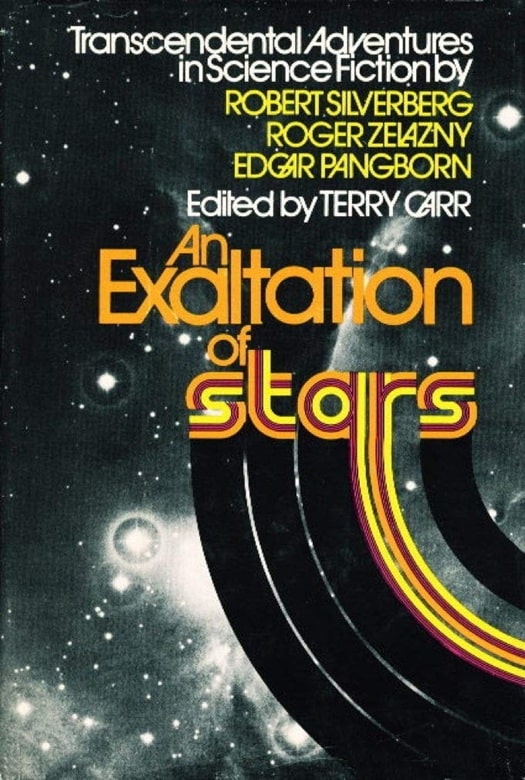
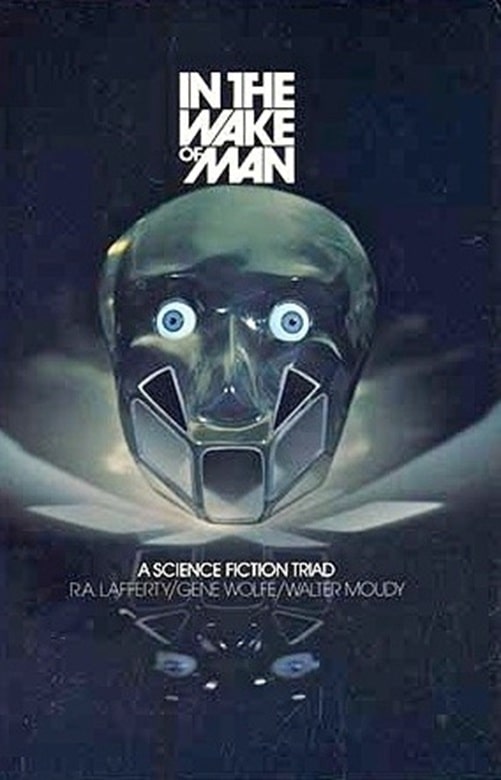
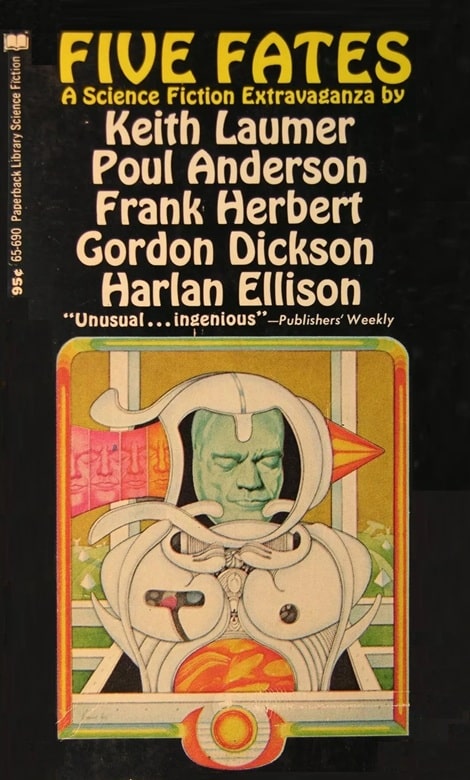
Other anthologies in a novella format: An Exaltation of Stars, edited by Terry Carr (Simon &
Schuster, June 1973), In the Wake of Man, edited by Roger Elwood (Bobbs-Merrill Company,
August 1975), and Five Fates, edited by Keith Laumer (Paperback Library, September 1971).
Cover art by Adelson & Eichinger, Nick Aristovulos, Lorraine Fox
The Anderson collaboration has four stories, all set on the title world, a creation of Anderson’s. (In this sense it mildly resembles the Twayne Triplets of the 1950s, which collected three novellas on the same subject, based on an introductory essay. Several of those books were planned, but in the end only two appeared, Witches Three and The Petrified Planet.) One other anthology of interest is a 1970 book put together by Keith Laumer, Five Fates, in which five writers continued a brief introduction by Laumer, in which a man goes to a Euthanasia center and begins to die — each writer then extrapolates what may happen to this man after (?) death.
Here are the eleven “novella” books Silverberg did.
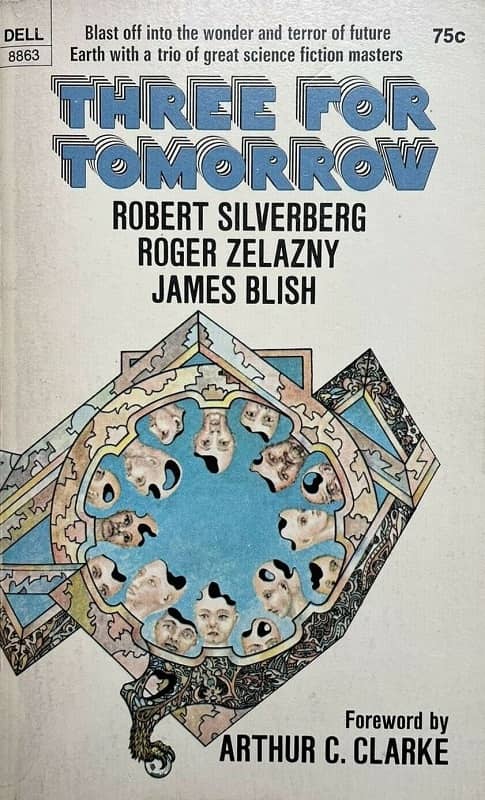
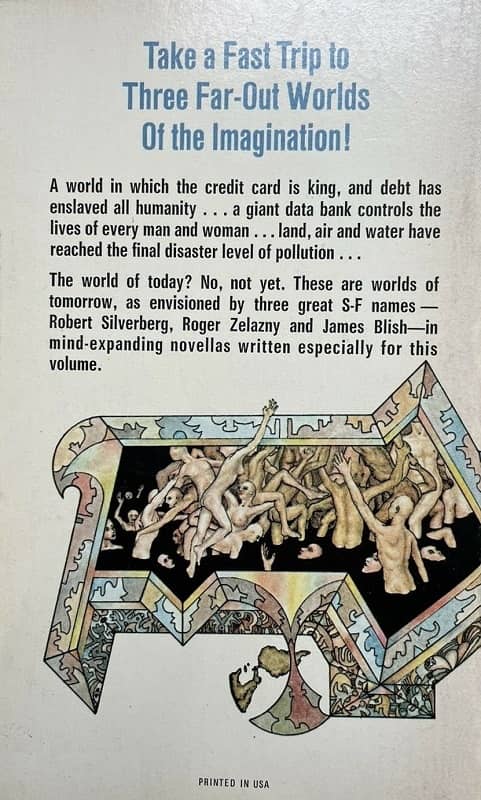
Three for Tomorrow (Dell, 1970). Cover uncredited
How It Was When the Past Went Away • novella by Robert Silverberg
The Eve of RUMOKO • novella by Roger Zelazny
We All Die Naked • novelette by James Blish
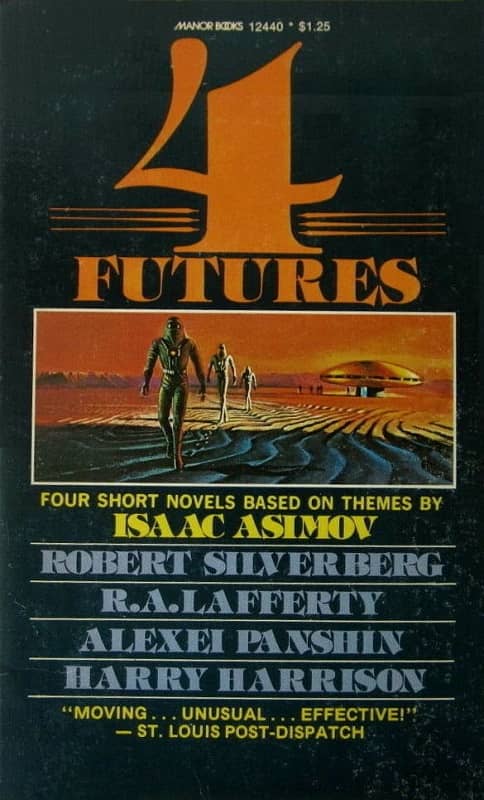

4 Futures (Manor Books, 1976 ). Cover by Bruce Pennington
Ishmael Into the Barrens • novelette by R. A. Lafferty
Brave Newer World • novelette by Harry Harrison
How Can We Sink When We Can Fly? • novelette by Alexei Panshin
Going • novella by Robert Silverberg

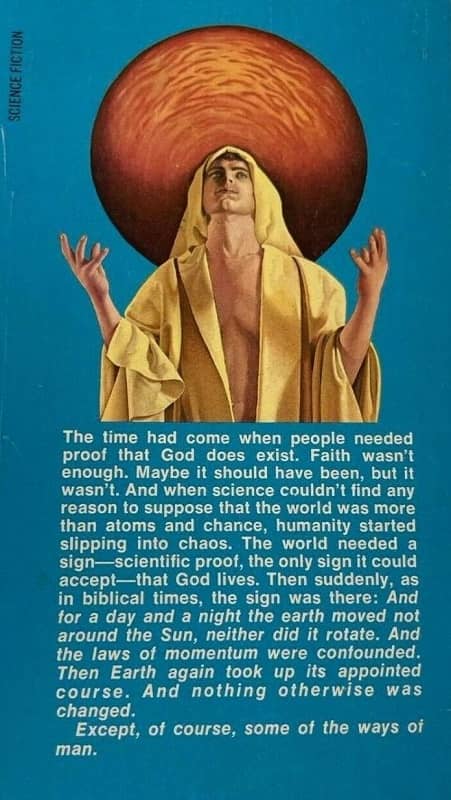
The Day the Sun Stood Still (Dell, 1975). Cover by Andy Lackow
Thomas the Proclaimer • novella by Robert Silverberg
A Chapter of Revelation • novella by Poul Anderson
Things Which Are Caesar’s • novella by Gordon R. Dickson
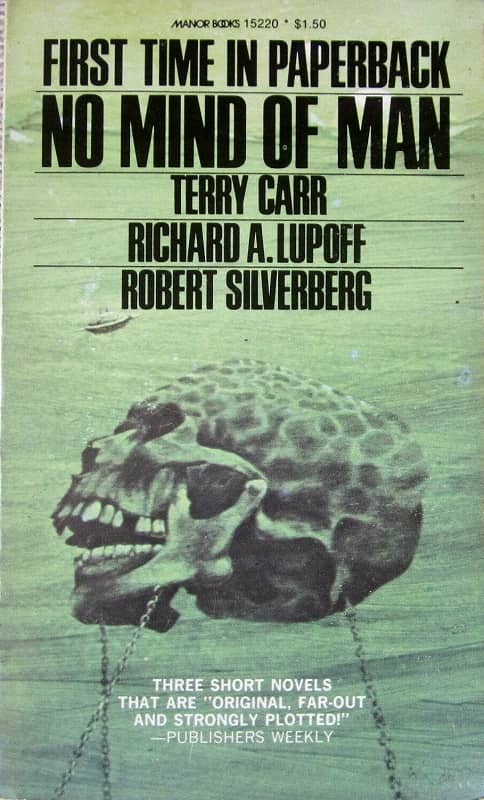
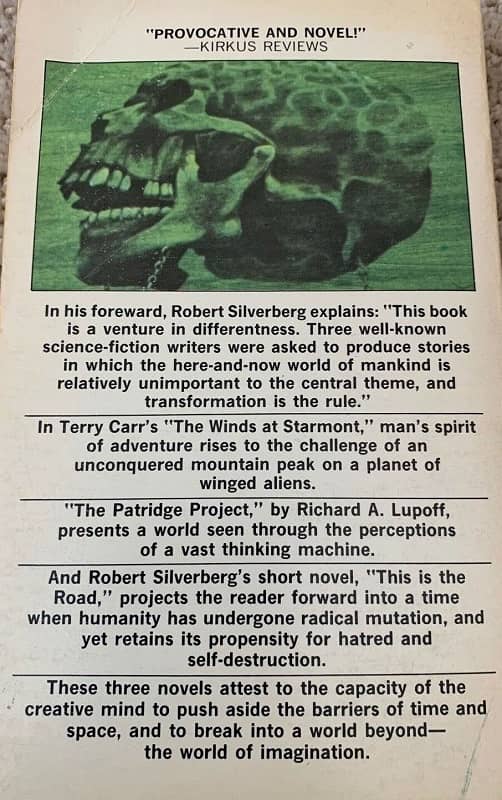
No Mind of Man (Manor Books, 1973). Cover uncredited
The Winds at Starmont • novella by Terry Carr
The Partridge Project • novella by Richard A. Lupoff
This Is the Road • novella by Robert Silverberg
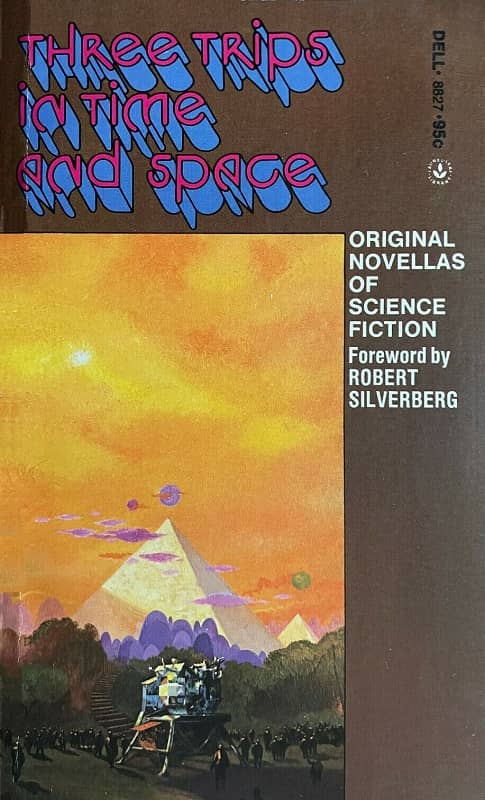
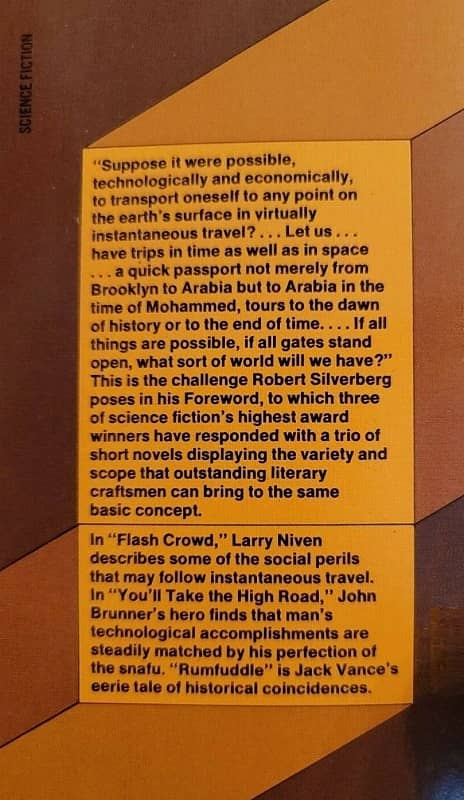
Three Trips in Time and Space (Dell, 1974). Cover by Paul Lehr
Flash Crowd • novella by Larry Niven
You’ll Take the High Road • novella by John Brunner
Rumfuddle • novella by Jack Vance
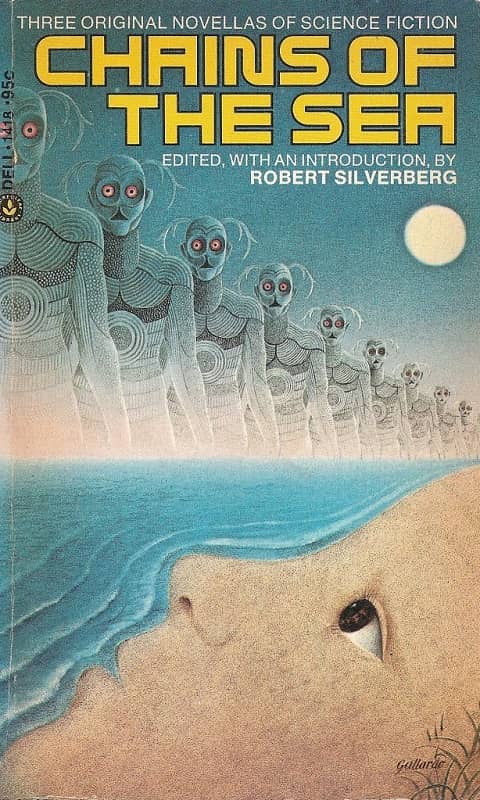
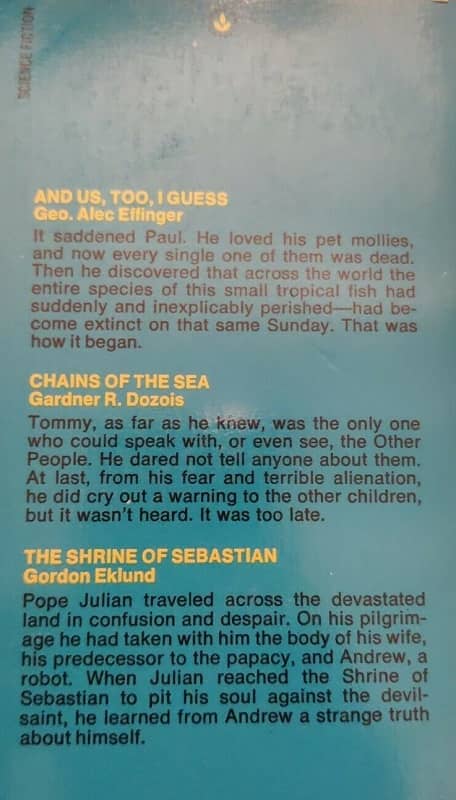
Chains of the Sea (Dell, 1974). Cover by Gervasio Gallardo
And Us, Too, I Guess • novella by George Alec Effinger
Chains of the Sea • novella by Gardner Dozois
The Shrine of Sebastian • novella by Gordon Eklund
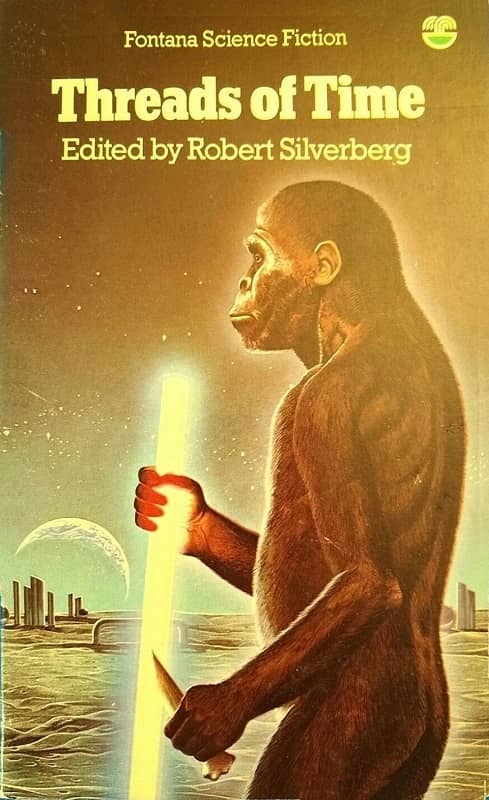
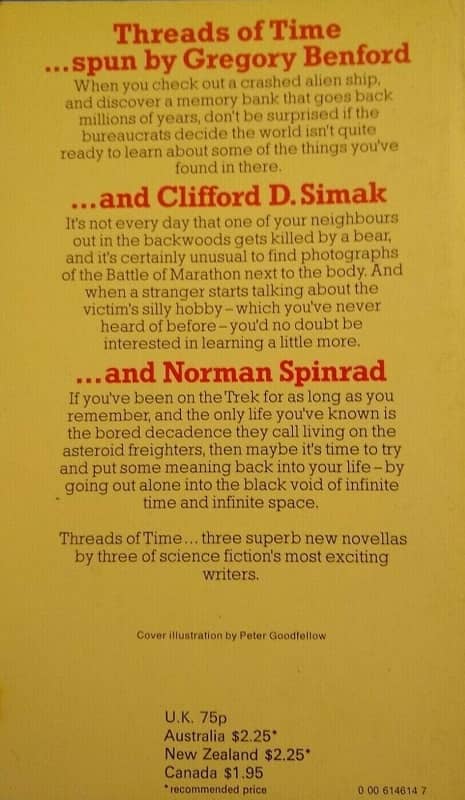
Threads of Time (Fontana, 1977). Cover by Peter Goodfellow
Threads of Time • novella by Gregory Benford
The Marathon Photograph • novella by Clifford D. Simak
Riding the Torch • novella by Norman Spinrad


The New Atlantis (Warner Books, 1978). Cover by Lou Feck
Silhouette • novella by Gene Wolfe
The New Atlantis • novelette by Ursula K. Le Guin
A Momentary Taste of Being • novella by James Tiptree, Jr.
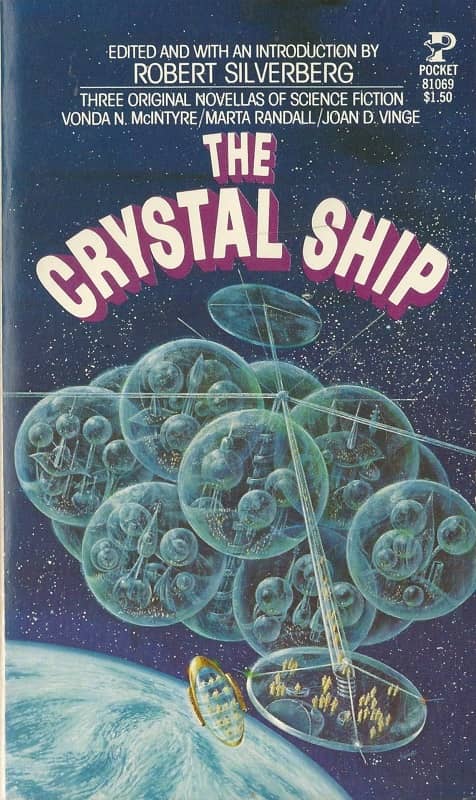
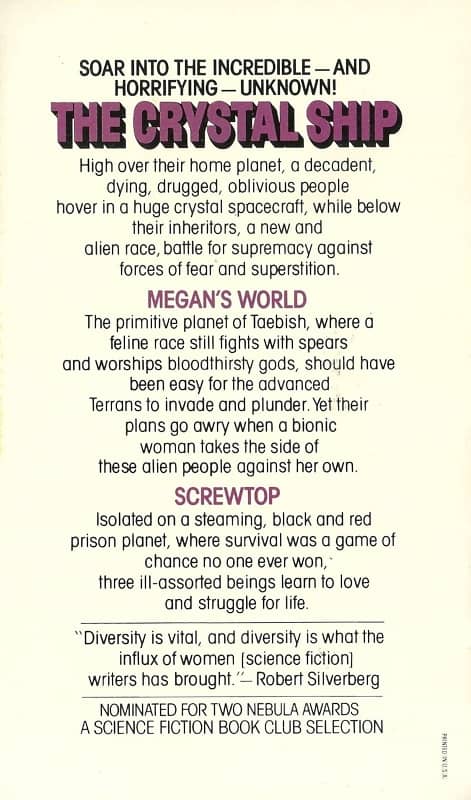
The Crystal Ship (Pocket Books, 1977). Cover byNorman Adams
The Crystal Ship • novella by Joan D. Vinge
Megan’s World • novella by Marta Randall
Screwtop • novella by Vonda N. McIntyre
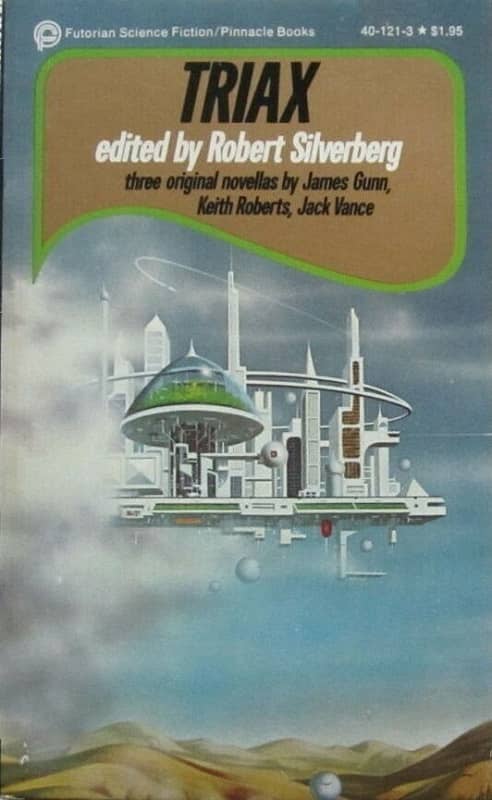
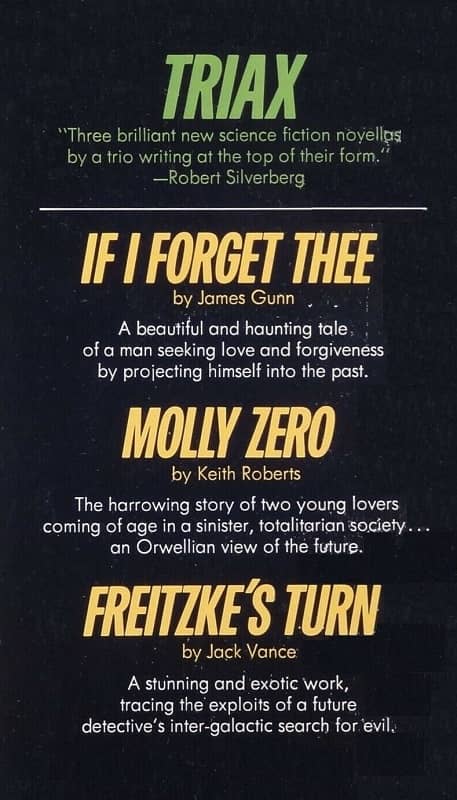
Triax (Pinnacle, 1977). Covers by Randy Weidner
Molly Zero • novella by Keith Roberts
If I Forget Thee • novella by James E. Gunn
Freitzke’s Turn • novella by Jack Vance
The Edge of Space hardcover edition (Elsevier/Nelson Books, 1979). Wraparound cover by Freff
The Edge of Space (1979)The King’s Dogs • novella by Phyllis Gotlieb
In the Blood • novella by Glenn Chang
Acts of Love • novella by Mark J. McGarry
Rich Horton’s last article for us was an obituary for Barry N. Malzberg. His website is Strange at Ecbatan. Rich has written over 200 articles for Black Gate, see them all here.
7 Author Shoutouts | Authors We Love To Recommend
Here are 7 Author Shoutouts for this week. Find your favorite author or discover an…
The post 7 Author Shoutouts | Authors We Love To Recommend appeared first on LitStack.
Party Planning Can Be Murder - Early Book Review
 Party Planning Can Be Murder: A Party Planner Mysteryby Kerry Schafer/Kerry Anne King
Party Planning Can Be Murder: A Party Planner Mysteryby Kerry Schafer/Kerry Anne KingWhat is it about:Wish List: pick up my pills from the pharmacy, plan my party, be there when I die…
Despite a few harrowing incidents with nervy Bridezillas, Addy Winters’ small town party planning business has been murder free – until now. But then, she’s never before been hired to throw a star-studded after-death party for a client who has their death scheduled on their calendar.
When Leno Masterson—former classmate, now legendary rocker with a flair for drama—turns up dead four days earlier than he’d planned, Addy suspects that someone helped him along. Sure, he left a melodramatic goodbye letter and his right-to-die paperwork is all in order, but even when the coroner rules natural causes, Addy isn’t buying it.
Addy’s family and friends – and Leno’s smolderingly hot brother Owen – warn her that she’s diving in over her head, and they’re right. She’s woefully unprepared for either the media onslaught or the secrets the people she thought she knew are hiding. But nothing is going to stop her from getting justice for Leno – and throwing a killer party while she’s at it.
If you love your mysteries with humor, heart, and a side of romance, this is your next must-read. Perfect for fans of Finlay Donovan and The Thursday Murder Club!
What did I think of it:There are some authors you follow to whatever genre they decide to write next. Kerry Schafer is one of those authors. When she switched from Urban Fantasy & Paranormal Thrillers to Women's Fiction as Kerry Anne King, I followed and loved those books as well. Her next release will be by both pen names and is a Murder Mystery!
You bet I jumped on the chance to be an early/ARC reader and let me tell you I devoured this book!
I was drawn in and emotionally invested from the first chapter. I fell in love with Addy and wanted her to succeed in everything she does. (I also thought some very not nice things about her family, apart from her brother and grandmother.)
I was already enjoying myself very much with this story when Leno turns up dead and the mystery begins. And I can tell you: there's tons of things Addy has to figure out to discover what happened to Leno. I couldn't stop reading: I needed to know who or what caused Leno's death.
The writing (as with every book Kerry has written) is so good in my opinion. There's lots of humorous situations and the writing fits those perfectly.
Voodoo Bride wants me to mention Owen: according to her Owen was the dreamiest and coolest character in the book. I myself can't say if he is indeed the dreamiest, but he for sure was a character I really didn't want to see ending up as the killer.
I'm not going to spoil the ending of course, but you can bet I want more books in what I hope will become a long series. I'll also grab the print version to hug and reread once this releases next month.
Why should you read it:It's an awesome Mystery read!
Expected publication: March 11, 2025
Review: Murder by Memory by Olivia Waite
 Buy Murder by Memory
OFFICIAL AUTHOR BIO: Olivia Waite writes queer science fiction, fantasy, historical romance, and essays. She is the romance fiction columnist for the New York Times Book Review.
Buy Murder by Memory
OFFICIAL AUTHOR BIO: Olivia Waite writes queer science fiction, fantasy, historical romance, and essays. She is the romance fiction columnist for the New York Times Book Review.FORMAT/INFO: Murder by Memory will be published by Tordotcom on March 18th, 2025. It is 112 pages long. It is available in ebook, hardcover, and audiobook formats.
OVERVIEW/ANALYSIS: When Dorothy Gentleman, ship's detective, wakes up in a body that isn't hers, she's more than a little annoyed. After all, she's supposed to be retired, her mind resting in the ship's Library until she decides to print a body again. And even if she'd chosen to wake up, she should be in a fresh body all her own. But there's been a murder on the ship, and what's worse, someone is deleting the memory archives from the Library itself - something that should be impossible.
Murder by Memory is a fluffy fun little appetizer that left me longing for a deeper dive into this world. The mystery itself is pretty straight forward. Dorothy goes from point A to B to C in fairly quick succession, following the clues on a mostly linear path. It's not going to scatter red herrings on your trail or give you a cast of suspects to consider. In fact, the mystery is less about the Who than it is about the Why and the How.
Instead, I was much more intrigued with puzzling out the ship the murder takes place on. The H.M.S. Fairweather is on a thousand year journey to a new planet. But with the technology to back up a person's mind, it's not a traditional generation ship; there isn't a constant turnover of populace because a person can simply print themselves into a fresh body when their old body gives out. This opens up a whole host of fascinating societal questions that Murder by Memory only barely begins to touch on, but it was enough of a glimpse that I wanted to know more.
I was also impressed by the way the author quickly sketched out her core cast of characters, from Dorothy herself to Ralphie her well-meaning but not always sensible nephew to his mysterious bartender boyfriend. They don't have deep backstories given the length of the novella, but I got enough of a sense of them that I wanted to spend more time with them, as much as I wanted to explore the ship.
CONCLUSION: Murder by Memory is like an episode of a weekly crime procedural. You'll know most of the beats, but you'll enjoy it anyway for the comfort of the familiar, and you'll want to return the cozy cast of characters. As this is the start of a new sci-fi mystery series, I'm definitely looking forward to more adventures in this world, but I do find myself wishing this were a main course instead of a snack.
What a Croc, Part II
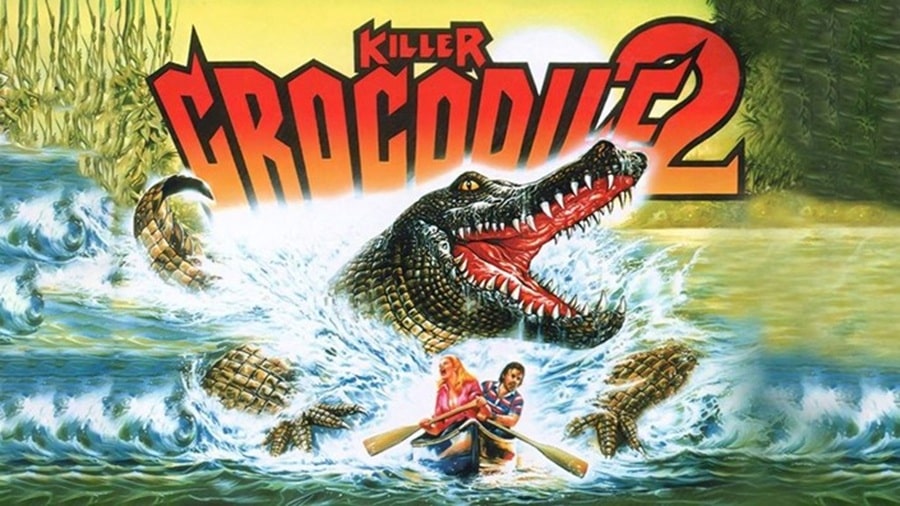 Killer Crocodile 2 (Fulvia Film, 1990)
Killer Crocodile 2 (Fulvia Film, 1990)
My next watch-a-thon is a favourite genre: crocs and gators. Unfortunately, this means the pickings are a bit slim, as I’ve already seen most of them, but I’ve managed to dig up 15 so far (supplemented with a Gila Monster and a couple of Komodos), and I’m sure the intended list of 20 will materialize as streaming services start suggesting titles.
Killer Crocodile 2 (1990) TubiCroc or gator? Crocodile. Again.
Real or faker? A hilarious puppet. The same one.
Any good? A direct follow on from the first story, this time the offspring of the first puppet is doing the chewing. Nefarious types are still dumping toxic waste, thrill seekers are still inexplicably wakeboarding in the world’s muddiest river, and ladies are still getting their kit off for a leaden leading man. Actually, the sexy pillow talk is a highlight. “Don’t you know that fear and near death situations stimulate and heighten a man’s reproductive organs?” Phwoar, steady on, love, you had me at ‘Don’t’.
[Click the images for gator-sized versions.]
The first film featured an unsettling attack on a small boy, but this one ups the ante by having a whole canoe-load of kids get eaten while a nun prays for salvation. Glorious hokum.
6/10
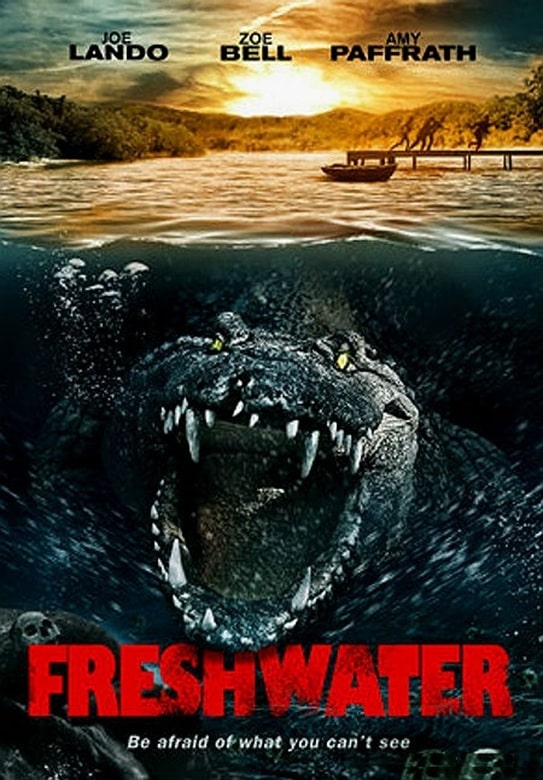
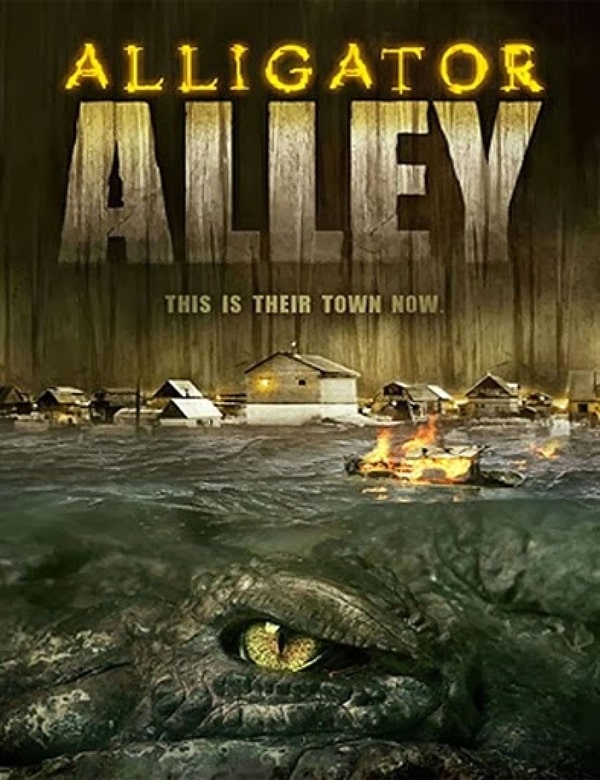
Freshwater (MultiVisionnaire, February 26, 2016) and Alligator Alley (Active Entertainment, 2013)
Croc or gator? Gator, possibly.
Real or faker? Let’s just say, when we do see a gator, it’s rubbish.
Any good? I’m torn, and not in a good way. There’s an awful lot wrong with this one, the script, the directing, the editing, the score (dear God, that score), most of the acting, the effects, and yet it tries something different (no spoilers, but it’s not what I was expecting) and I applaud the ballsy ending.
However, when the intended humor falls flat but your audience laughs at everything else, that ain’t good. Makes for a good drinking game if you are counting poor decisions (the first being to watch this optimistically).
5/10
Alligator Alley (2013) YouTubeCroc or gator? Gators!
Real or faker? Reasonably dodgy CG.
Any good? Also known as Ragin Cajun Redneck Gators, you know exactly what to expect going into this SyFy slice of grilled ham, and yet it upends those expectations with a hearty fart in the face. Toxic moonshine mutates gators into dart firing rascals whose bites turn folks into more gators (I kid you not). It’s all set against the backdrop of a family feud down south, and is as ludicrous as you might imagine.
It’s rubbish, but it’s daft rubbish, which is about as good as it gets these days, so I’m not hating it.
6/10
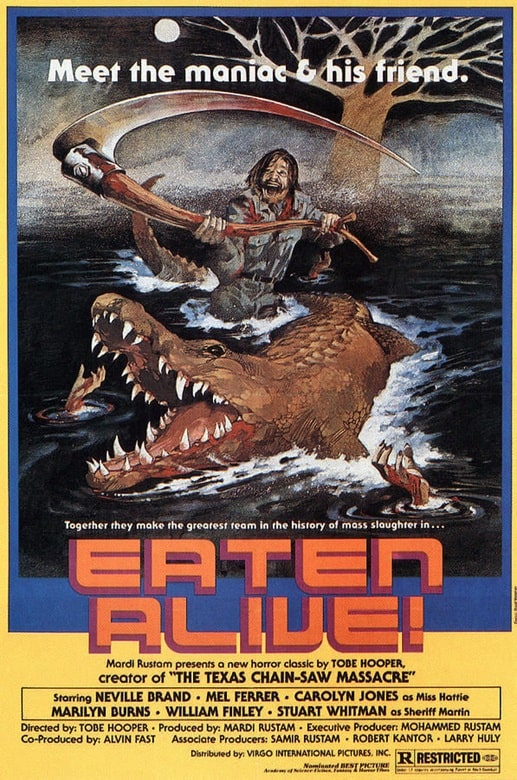
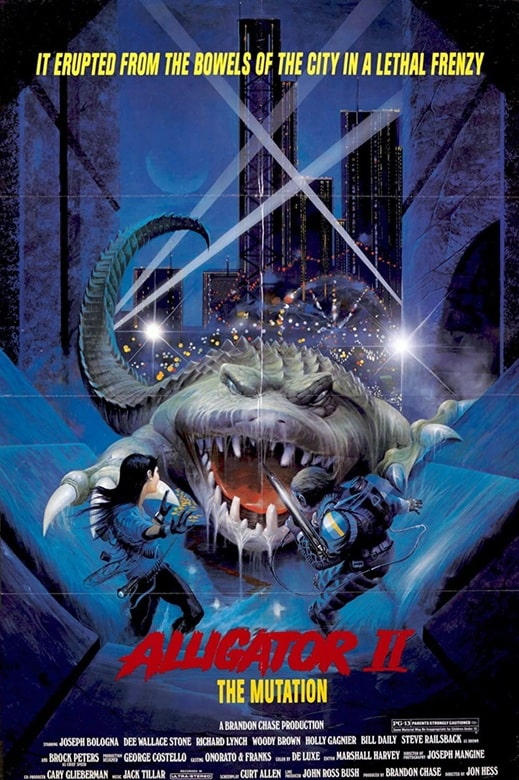
Eaten Alive (Mars Productions, October 18, 1976) and Alligator II: The Mutation (New Line Cinema, June 5, 1991)
Croc or gator? Nile Croc!
Real or faker? Cute papier mache monster.
Any good? Some good has come out of this ill-considered project, for I have finally watched the missing Tobe Hooper film in my life — a film banned in the UK until 1998 as part of Mary Whitehouse’s Video Nasty apocalypse. Though tame by today’s standards, the film does come with a warning for modern audiences as besides a bit of gore, it contains racial slurs and attempted rape.
This is Robert Englund’s first film role, and his big screen intro is “My name’s Buck, and I’m here to fuck.” Funny to think that he was roomies with Mark Hamill at the time, who was busy on his own little film.
The entire film is shot on a soundstage, and although the grimy motel is impressive enough, the exterior shots have an unearthly quality to them, surreal, dreamlike, bathed in red neon and resembling the last days. It’s atmospheric as all heck, with killer sound design, but it might be an uncomfortable watch for some (women are only present to get undressed). Neville Brand as the Norman Bates-ish ‘Judd’ is excellent, and the croc itself gets to do some fun chomping.
8/10
Alligator 2: The Mutation (1991) YouTubeCroc or gator? Alligator.
Real or faker? Stock footage and a rubbish puppet.
Any good? 11 years after the excellent and enjoyable first movie, someone decided to remake it, but make it boring. This film is missing two key ingredients, Robert Forster and a decent alligator.
Richard Lynch, Steve Railsback and Dee Wallace are welcome additions, but even they can’t save this dull ordeal. The story is the same as the first — a sewer alligator grows big and mean due to toxic waste, a corrupt businessman throws a party, rinse, repeat. However, where the first film kept its tongue in its cheek and actually showed us a big ol’ alligator, this one relegates its rubbish effects to the dark of the sewers, ensuring we see nothing for most of the film. Dull.
4/10
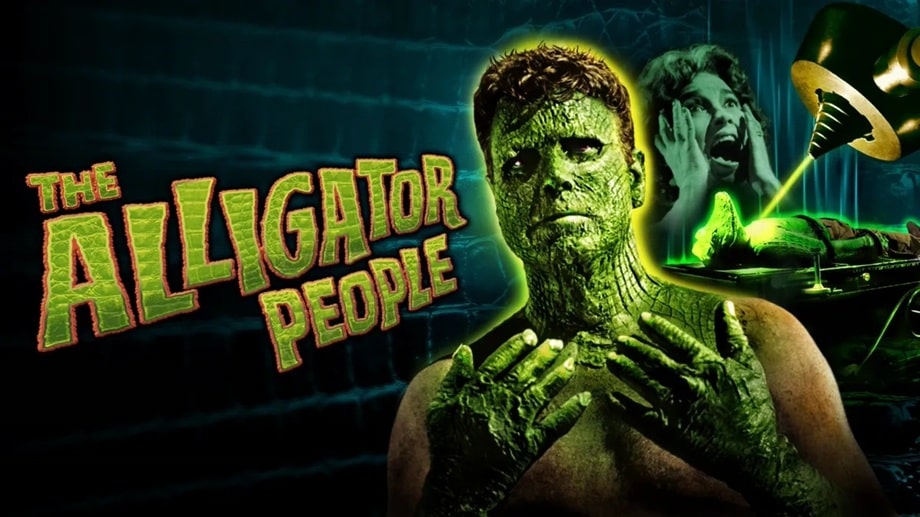 The Alligator People (20th Century Fox, July 22, 1959)
The Alligator People (1959) Disney+
The Alligator People (20th Century Fox, July 22, 1959)
The Alligator People (1959) Disney+
Croc or gator? Alligator people!
Real or faker? Real gators and some great makeup.
Any good? One of those classics that somehow passed me by — I suspect the hokey still used in every book didn’t inspire much confidence in me — but I was horribly mistaken. Far from being the B-movie cheesefest I was expecting, it was surprisingly compelling, with a decent plot, lovely writing (the narration is poetic) and makeup by none other than Ben Nye and Dick Smith!
Lon Chaney is creepy as all heck, Beverly Garland is lovely, and the whole affair drips atmosphere and dangly moss. There’s a bit of abuse aimed at some (real) gators, so animal lovers beware, but I ended up both enthralled and charmed and I’m very happy to finally tuck this one away.
8/10
Previous Murkey Movie surveys from Neil Baker include:
What a Croc, Part I
Prehistrionics
Jumping the Shark
Alien Overlords
Biggus Footus
I Like Big Bugs and I Cannot Lie
The Weird, Weird West
Warrior Women Watch-a-thon
Neil Baker’s last article for us was What a Croc, Part I. Neil spends his days watching dodgy movies, most of them terrible, in the hope that you might be inspired to watch them too. He is often asked why he doesn’t watch ‘proper’ films, and he honestly doesn’t have a good answer. He is an author, illustrator, outdoor educator and owner of April Moon Books (AprilMoonBooks.com).
Teaser Tuesdays - The Spellshop
 Kiela never thought the flames would reach the library. She was dimly aware that most of the other librarians had fled weeks ago, when the revolutionaries took the palace and defenestrated the emperor in a rather dramatic display.
Kiela never thought the flames would reach the library. She was dimly aware that most of the other librarians had fled weeks ago, when the revolutionaries took the palace and defenestrated the emperor in a rather dramatic display.(page 1, The Spellshop by Sarah Beth Durst)
---------
Teaser Tuesdays is a weekly bookish meme, previously hosted by MizB of Should Be Reading. Anyone can play along! Just do the following: - Grab your current read - Open to a random page - Share two (2) “teaser” sentences from somewhere on that page BE CAREFUL NOT TO INCLUDE SPOILERS! (make sure that what you share doesn’t give too much away! You don’t want to ruin the book for others!) - Share the title & author, too, so that other TT participants can add the book to their TBR Lists if they like your teasers!
A HOUSE with GOOD BONES by T. Kingfisher
Monday Musings: Here We Are

 We woke this morning to a snow squall, something that happened with ever-decreasing frequency during our years in Tennessee, as climate change made the warm South even warmer. Here in New York, during the winter months, snow is still the default when there’s precipitation, and I love that. I have missed snow and don’t mind paying the plow guy or dealing with snow on the walkways and driveway. The beauty of an early morning snowfall more than makes up for the inconveniences.
We woke this morning to a snow squall, something that happened with ever-decreasing frequency during our years in Tennessee, as climate change made the warm South even warmer. Here in New York, during the winter months, snow is still the default when there’s precipitation, and I love that. I have missed snow and don’t mind paying the plow guy or dealing with snow on the walkways and driveway. The beauty of an early morning snowfall more than makes up for the inconveniences.
We have bird feeders up now, and they’ve drawn in a variety of species, including several species of sparrow, goldfinches and cardinals, chickadees and nuthatches and woodpeckers. They have also drawn the attention of local hawks, who seem to view our feeders as an all-they-can-eat avian buffet. We have a Cooper’s Hawk who frequents the yard, a pair of Red-tails who come around quite often, and, as of yesterday, a gorgeous Red-shouldered Hawk. Our turkey flock continues to wander through the yard now and then, as does a beautiful red fox. A couple of weeks ago, while driving past the farm that borders our property on the western edge, I spotted a young Peregrine Falcon perched on a telephone pole, hungrily eyeing a flock of doves.
I haven’t written in this blog for a few weeks, and in a way what you’ve just read is why. I am working again, we have settled into a routine of sorts. The house still needs a good deal of work, and we’re getting around to that slowly, steadily. We are enjoying this setting immensely. We’re eating fun foods and finding new stuff to stream. We’re spending lots of time with my brother and his family, who live close by, and lots of time with my college roommate and musical partner and his wife, who also live maybe 20 minutes from here.
Life is comfortable and peaceful and, I will also admit, a tiny bit boring. Not to me, mind you, but I can definitely see where it could seem that way to those on the outside. We traveled a lot last year. This year we’re planning to (mostly) stay put and work on our new place. The past several years have been full and fraught, difficult beyond words at times, and at other times so frantic as to be exhausting. This year won’t be like that. Not if we can help it.
And so, yeah, I have struggled to post. I don’t want to bore. I don’t want to repeat material from old posts.
I continue to grieve for my older daughter. I’ll never stop. But I feel I have made that grief part of my life, part of who I am now, and honestly, I wouldn’t have it any other way. I don’t feel the same need to write about it that I felt last year. And I think many grew tired of such posts. Grief is part of me, but it does not — should not — define me.
I don’t really want to think about the slow-motion disaster unfolding in our nation’s capital. This administration’s attempts to subvert the Constitution and undo a century of progress on Civil Rights, environmental protection, social justice, and a host of other worthy goals is not something upon which I care to dwell. I am too weary to engage in online flame wars with troglodytes and nazis. At some point, I’ll grow angry enough to write a political screed or three, but not now.
And at some point, I am sure, I will have much to say about new writing projects. For now, though, I’m merely editing, and enjoying quiet, productive days in my new work space.
All of this feels healthy, and deeply appropriate for this current stage of my life. None of it makes for exciting reading (or writing). I will do my best to post as I can, to come up with things to say that make something worth reading out of our mundane-albeit-cozy existence. But to those who know us and care about us, please be assured that we are doing well. Better than we would have thought possible a little over a year ago. Some days are harder than others. But we are where we ought to be, physically and emotionally. It’s hard to ask for more.
Wishing all of you a wonderful week.
Spotlight on “Flux” by Jinwoo Chong
Flux is a New York Times Editor’s Choice, Best Book of 2023 by Esquire, Apple…
The post Spotlight on “Flux” by Jinwoo Chong appeared first on LitStack.



Recent comments